In the world of music creation, chord progressions play an integral role in determining the mood and emotion a song conveys.
Notably, certain sequences have the power to instill an undeniable sense of joy and optimism in listeners.
This is particularly prominent in the realm of ‘happy’ chord progressions, which, as the name suggests, contribute to creating uplifting, happy music.
Understanding and mastering these progressions can open new avenues for both novice, and experienced, composers and songwriters.
From the cheerful tunes of a catchy pop song to the elevating scores in cinematic soundtracks, their applications span across diverse musical genres.
This post aims to delve into this subject, providing useful insights to help enhance your musical creativity.
Table of Contents
- Happy Chord Progressions
- I-IV-V (1-4-5)
- I-IV-vi-V (1-4-6-5)
- II-V-I (2-5-1)
- I-V-IV (1-5-4)
- vi-IV-I-V (6-4-1-5)
- I-V-vi-IV (1-5-6-4)
- I-ii-iii-IV (1-2-3-4)
- I-iii-IV-V (1-3-4-5)
- II-IV-V-II (2-4-5-2)
- IV-V-I (4-5-1)
- ii-vi-V (2-6-5)
- I-ii-IV-V (1-2-4-5)
- V-IV-I (5-4-1)
- ii-V-IV-I (2-5-4-1)
- vi-V-IV-I (6-5-4-1)
- I-vi-IV-V (1-6-4-5)
- vi-II-V-I (6-2-5-1)
- I-V-IV-ii (1-5-4-2)
- vi-IV-V-I (6-4-5-1)
- I-iii-vi-IV (1-3-6-4)
- I-IV-V-vi (1-4-5-6)
- V-iii-IV-I (5-3-4-1)
- I-vii°-vi-IV (1-7-6-4)
- IV-iii-ii-I (4-3-2-1)
- V-I-IV-vi (5-1-4-6)
- The Bottom Line
Happy Chord Progressions
I-IV-V (1-4-5)
The upbeat backbone of joyful anthems and upbeat pop confections.
The I-IV-V progression (1-4-5) is one of the most common chord progressions in popular music, known for its upbeat and happy sound. Utilized in numerous genres, from blues to rock to pop, this progression creates an uplifting energy that can significantly enhance your musical compositions.
- Difficulty: Easy
- Example: G – C – D (Key of G major)
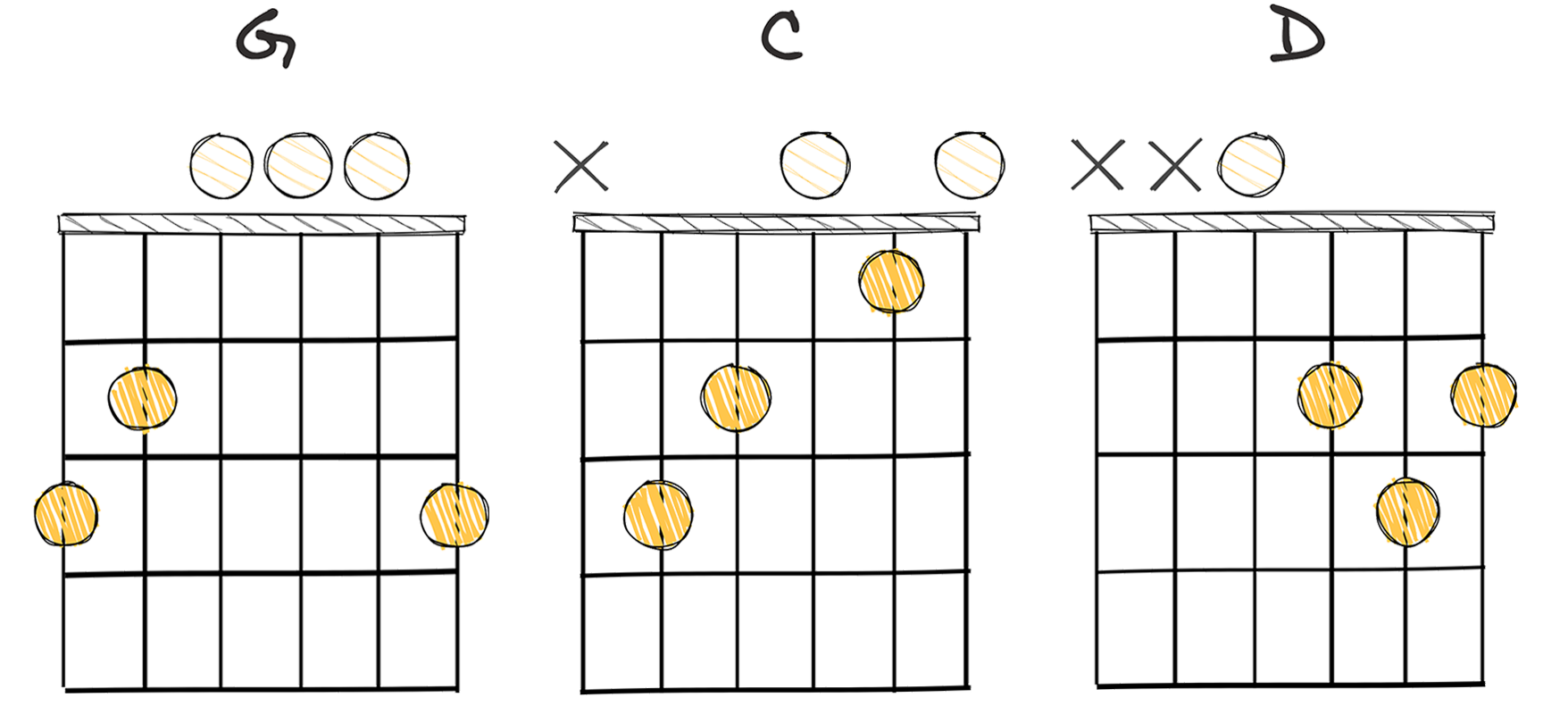
The I-IV-V (1-4-5) chord progression carries a long and storied history within the realm of music.
As an elementary chord progression, it has not only been around for a long time, but it also forms the base of numerous popular songs throughout the years.
Nicknamed the “doe-ray-me” progression, due to its simplicity, the I-IV-V chord progression is often the first progression taught to budding musicians.
The simplicity of this progression makes it an obvious choice for introductory music education.
The I-IV-V progression’s easy hand movements on instruments such as the guitar or piano makes it playable even for beginners
Unlike more complex chord progressions, it does not demand a deep understanding of music theory, allowing novice musicians to start playing songs quickly.
Despite its simplicity, the I-IV-V progression plays a fundamental role in the construction of melodies and harmonies.
To have such an extensive influence, spanning across decades of music history, shows the bold efficacy of the I-IV-V progression in bringing a sense of joy and optimism to various musical styles.
This progression’s ability to shape the emotional outlook of a musical piece is a testament to its power.
Therefore, understanding the usage of the I-IV-V progression could certainly uplift your musical spirit and create a positive impact on your musical journey.
I-IV-vi-V (1-4-6-5)
A joyfully uplifting progression, ideal for sparking musical positivity.
This progression, consisting of the first (I), fourth (IV), sixth (VI), and fifth (V) chords, is often utilized in music for its uplifting and motivational tone. The transition from the harmonious IV to a surprising VI, and finally resolving on the V, creates an emotionally satisfying journey that leaves listeners feeling positive and energized.
- Difficulty: Easy
- Example: G – C – Em – D (Key of G major)
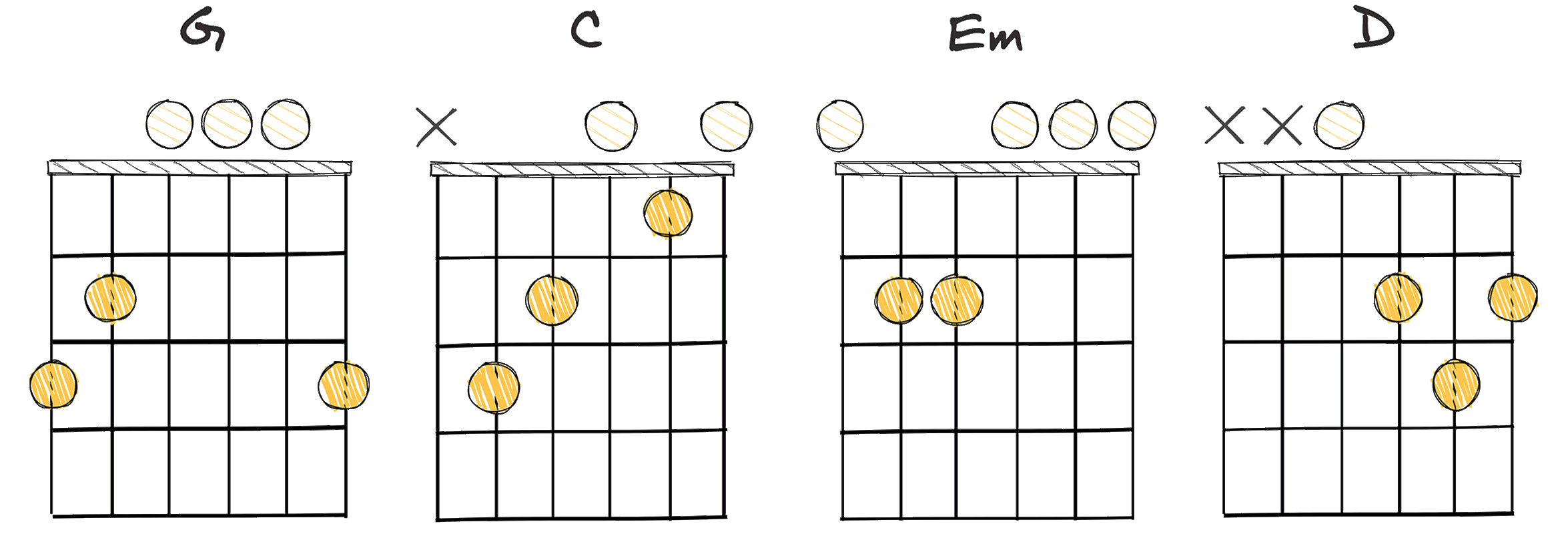
It’s undeniable that some of the most uplifting and joyful sounds in music spring from happy chord progressions.
One such progression that holds massive ability to uplift your musical spirit is the I-IV-vi-V sequence, represented numerically as 1-4-6-5.
This wonderfully melodic chord progression can turn a song’s mood from melancholic to exultant in an instant.
The I-IV-vi-V progression has a simple structure that, due to its commonality, will sound familiar to most listeners.
It’s a progression that dips into the submediant – the sixth degree of the diatonic scale – resulting in a surprisingly emotive quality.
The submediant introduces an element of surprise into the composition, giving listeners an unexpected break from the usual tonic-dominant interchange.
What’s fascinating about this progression is its history.
Historically, the I-IV-vi-V progression originated from the Baroque period of Western classical music, where composers started incorporating more complex harmonic structures into their work.
It has stood the test of time and is used extensively in modern genres.
Its relevance in today’s music landscape is a testament to its timeless beauty.
Its versatility allows it to be used in a variety of musical genres, from pop to rock, blues to soul, and pretty much anything in between.
It’s a core foundation in the world of harmony.
Indeed, the I-IV-vi-V chord progression’s versatility is immense.
Its ability to effortlessly blend into various musical styles makes it a universal favorite among songwriters across different eras and genres.
It’s the secret ingredient that brings vibrancy and soul to a piece.
The chords in the I-IV-vi-V progression are also easy to play.
This makes it an excellent progression for beginners trying to explore different sonic landscapes.
Learning this progression can significantly improve one’s artistic flexibility and musical proficiency.
While it’s impossible to capture the magic of music in mere words, the I-IV-vi-V chord progression is undeniably a powerhouse of a progression.
Whether you’re a novice just starting out or a seasoned musician looking for some fresh inspiration, the I-IV-vi-V progression is something you’ll want to experiment with, delve into and revel in its infectious rhythm.
Regardless of whether you’re on the listening end or crafting your masterpieces, the harmonic beauty of the I-IV-vi-V progression is bound to uplift your musical spirit and spark joy in your creative journey.
II-V-I (2-5-1)
An uplifting and harmonious celestial journey within three chords.
The II-V-I progression is a popular harmonic pattern in the music world often used to evoke the feeling of happiness and positivity in the listener. These three chords often act as a form of musical resolution in a song, allowing it to transition smoothly from tension to a pleasant conclusion, thereby eliciting a cheerful and uplifting mood.
- Difficulty: Easy
- Example: E – A – D (Key of D Major)
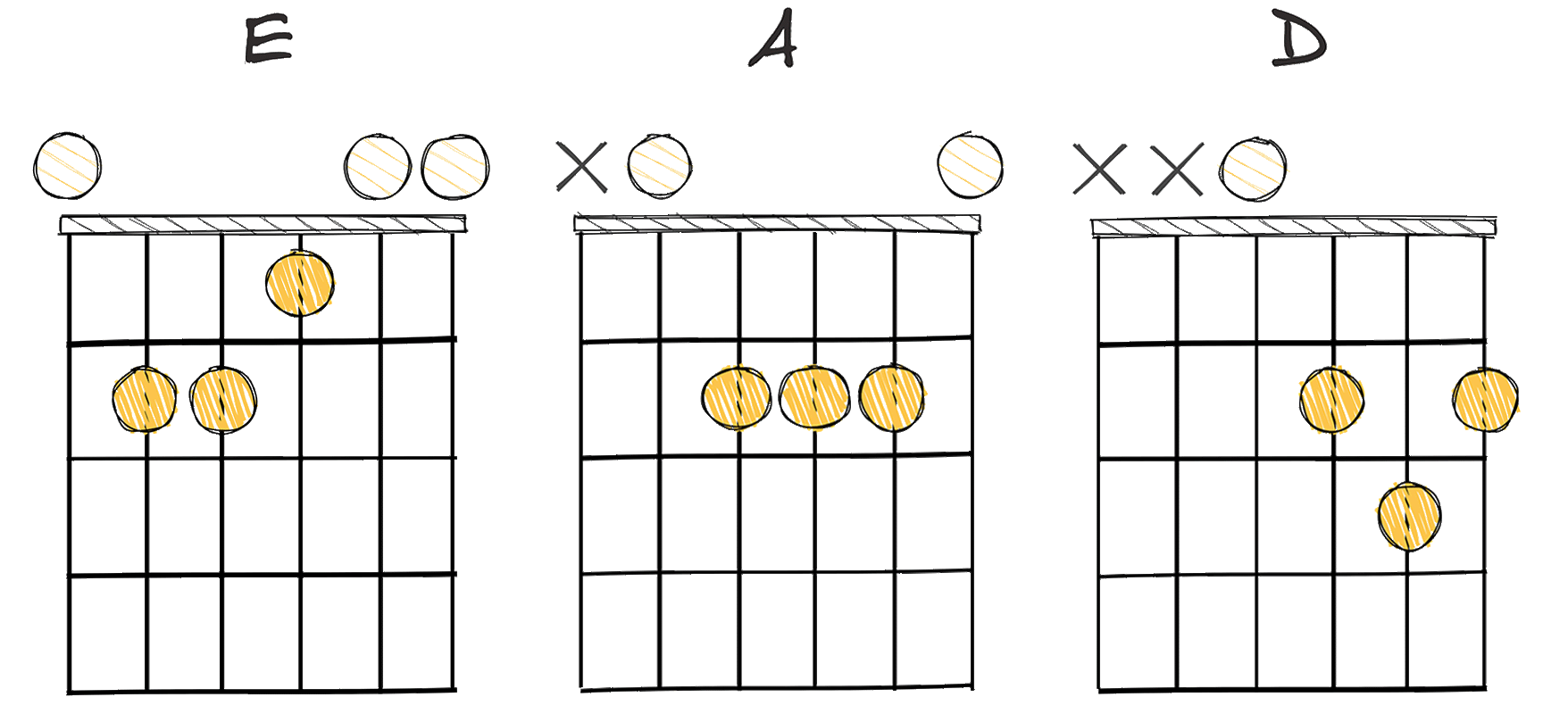
When it comes to creating a harmonious melody that can instantly lift your spirits, your chord progressions are the main players involved.
They are the magical recipes that create the musical cuisine we come to enjoy.
The chord progression II-V-I (2-5-1), not only possess a certain naturality and smoothness, it has also proven its worth in countless songs throughout history.
Our progression, II-V-I (2-5-1), became popular in the 20th century and it’s characterized by its pivotal role in Jazz music.
It is often referred to as the ‘backbone’ of jazz compositions.
The beauty of this progression lies in its cyclical nature, giving the song a sort of pull back to the beginning after reaching the end.
The beauty of this progression lies in its cyclical nature, giving the song a sort of pull back to the beginning after reaching the end.
The above statement is particularly significant because it not only enhances the rhythm but also contributes to the overall melody of the song.
This cyclical nature compels a listener to instantly connect with the song, making it sound happy, uplifting and musically intriguing.
Furthermore, II-V-I (2-5-1) chord progression is favorable for its simplicity to play, especially for beginners.
This chord progression can be easily achieved, with a little practice, thus providing an easy pathway for those learning the ropes of creating an enticing melody.
This progression is not only limited to the jazz genre but it has also served as a foundational progression in pop, rock, and classical music.
Its popularity lies in its ability to make a tune sound full and complete.
On applying this progression to the key of D Major, we get the chords E – A – D.
You can easily recognize this progression in countless melodies including some of your favorite songs.
The use of II-V-I (2-5-1) progression in such diverse songs is a testament to its versatility.
It goes to show how this easy to play, yet impactful chord progression can create an enriching musical experience.
Whether you are an aspiring musician seeking to compose your first melody or an experienced one trying to diversify your tune, working with the II-V-I chord progression can be a game-changer.
It is indeed a toolbox essential for every musician dreaming to create a happy, uplifting tune.
I-V-IV (1-5-4)
A cheerful progression bringing joy and lightness to any composition.
The I-V-IV chord progression, also known as 1-5-4, is a bright and uplifting harmonic pattern that can really boost a song’s energy and spirit. It’s especially popular in genres like pop and rock, with its major key foundation injecting a sense of joy and positivity into the music it’s part of.
- Difficulty: Easy
- Example: G – D – C (Key of G major)
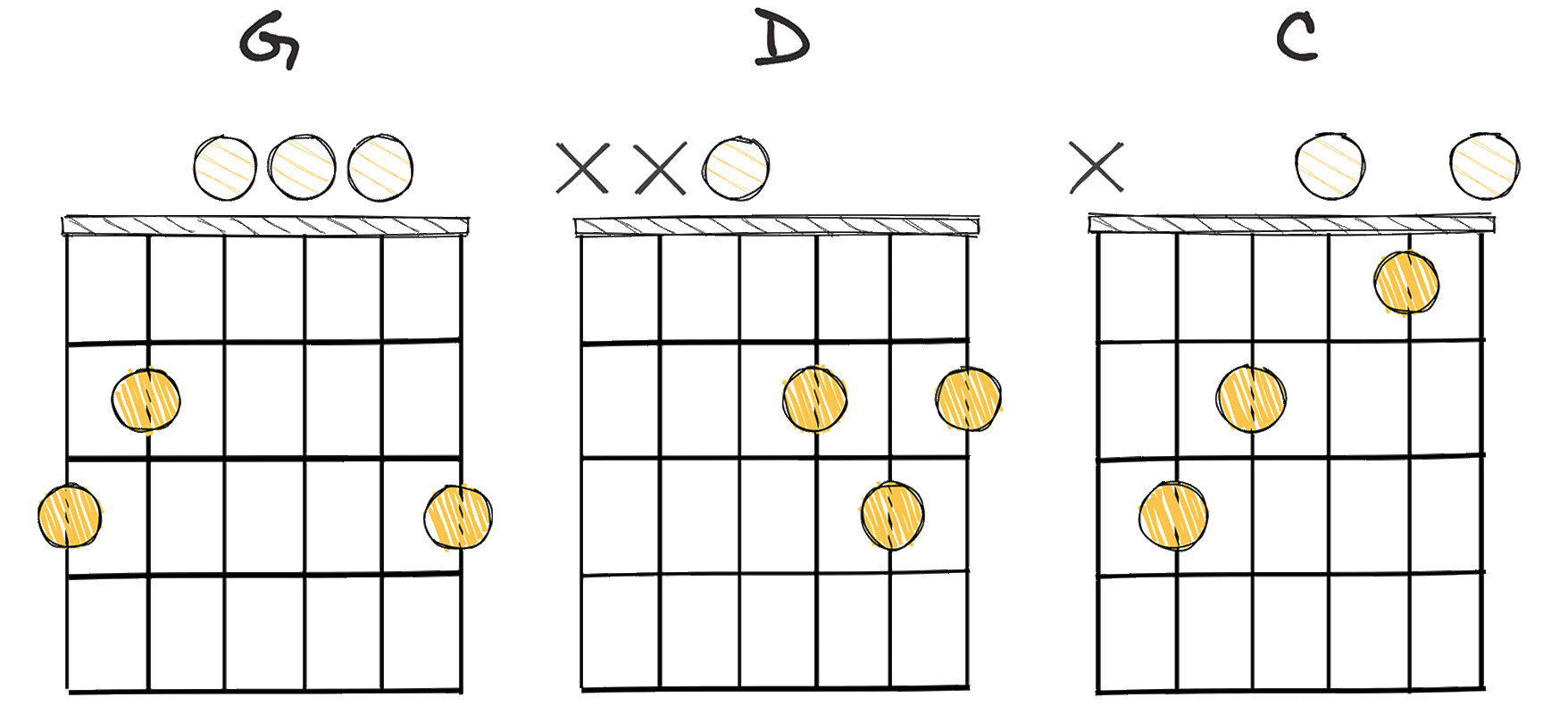
The I-V-IV chord progression has a long and storied history, and its cheerful, bright sound has uplifted the spirits of countless musicians and listeners alike.
The I-V-IV progression, also known as the 1-5-4 progression in numeric notation, is particularly popular in rock and pop genres, adding a joyful and energetic vibe to any composition.
One might wonder why this particular chord progression has such an uplifting and happy vibe.
The answer lies in how the chords progress musically.
They produce a pleasing harmonic relationship that our ears naturally gravitate towards.
Historically speaking, I-V-IV is deeply rooted in the structure of Western music, appearing in numerous genres, from blues and folk, through to contemporary pop and rock.
This popular chord progression has been used by many celebrated artists throughout music history.
The I-V-IV sequence creates a sound that’s both familiar and comforting to the ears of listeners worldwide.
This allows the songwriter to convey a sense of joy and uplifting spirit, making it a favorite choice for compositions aimed at inspiring and energizing listeners.
Despite its historical usage, the I-V-IV progression remains a powerful tool today, primarily due to its simplicity and versatility.
From a technical standpoint, the I-V-IV chord progression is remarkably easy to play on a variety of musical instruments.
Because of this, the I-V-IV progression is often one of the first patterns beginner musicians learn and absorb.
The I-V-IV chord progression has been and remains a vital element in the structure of Western music, helping to create some of the most iconic songs and uplifting musical moments in history.
vi-IV-I-V (6-4-1-5)
A cheerful progression evoking uplifting vibes and a joyful spirit.
The vi-IV-I-V progression is a distinctly cheerful and uplifting sequence of chords that can effectively cultivate a positive and joyous mood in musical compositions. Utilizing the 6th, 4th, 1st, and 5th chords in a major scale, this progression offers an array of melodic potential that can transform any piece into a vibrant and spirited composition.
- Difficulty: Easy
- Example: Bm – G – D – A (Key of D major)
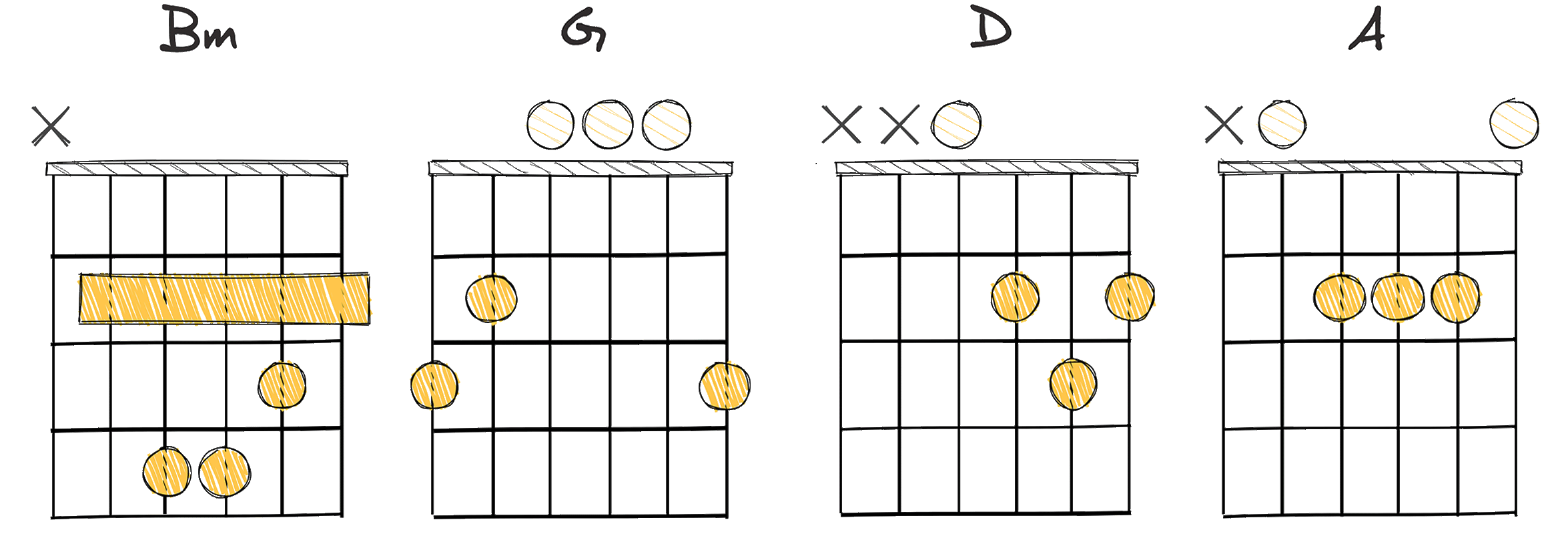
When it comes to captivatin and uplifting music, the vi-IV-I-V chord progression, also denoted as 6-4-1-5, stands out significantly in its magical ability to elicit a sense of joy.
The history and usage of this progression in music is as intriguing as the music it produces.
This progression is often chosen due to its ease of play.
Particularly for budding musicians and newbies to the musical world, the vi-IV-I-V progression provides a relatively comfortable entry point.
The ease of this chord progression unexpectedly results in complex melodies and emotionally rich music.
Its simplicity does not compromise the quality, emotions or depth of the music.
In reality, the straightforwardness of the progression often aids in the creation of complex melodies and emotionally rich music.
This wonderfully versatile chord progression is repeatedly chosen by musicians worldwide to create happy, uplifting music.
From pop and rock genres to contemporary and classical music, its impact and usage are far-reaching and universal.
I-V-vi-IV (1-5-6-4)
An uplifting, heartwarming progression that never fails to inspire joy.
The I-V-vi-IV chord progression is a radiant sequence that’s often used to construct upbeat, joyful melodies due to its light and satisfying resolution. Resonating with an intrinsic optimism, it’s a ubiquitous tool in a songwriter’s palette, contributing to a tune’s affirmative and uplifting musical ambiance.
- Difficulty: Easy
- Example: C – G – Am – F (Key of C major)
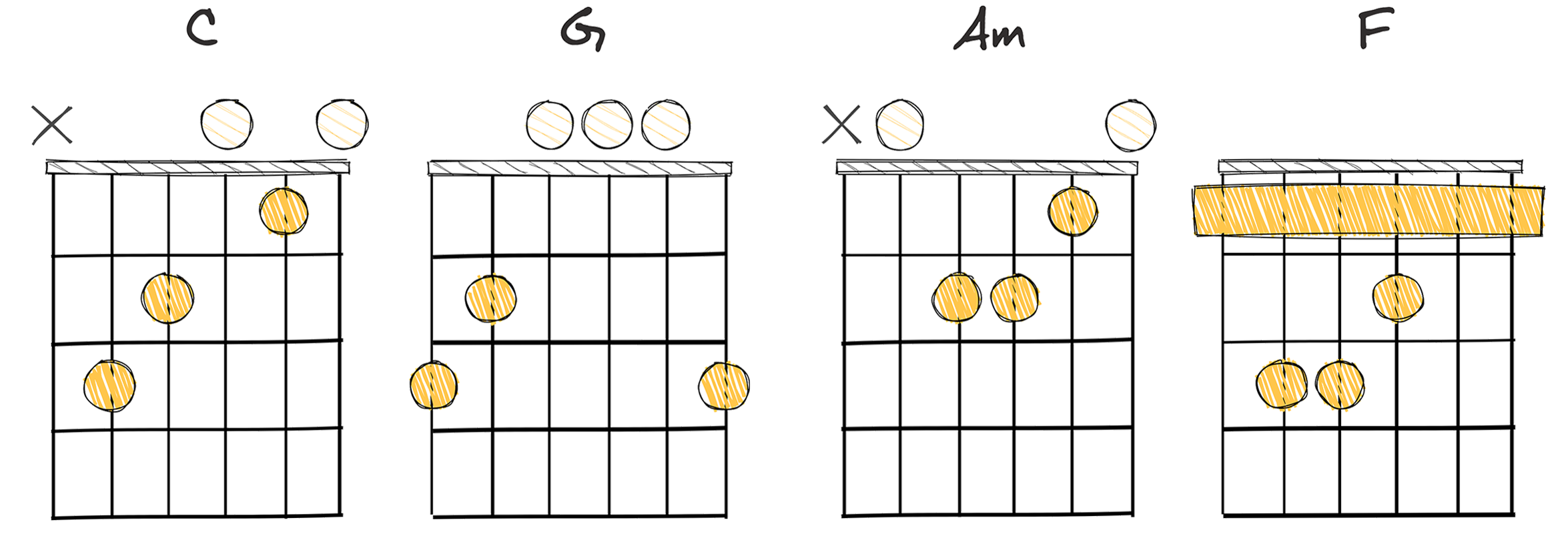
When it comes to happy chord progressions, the I-V-vi-IV sequence stands as one of the most popular and uplifting.
This harmonic progression, often seen in pop music and many other genres, tends to give a feel-good vibe that stimulates positive feelings in the listeners.
So, despite its simplicity, the I-V-vi-IV chord progression is a potent musical tool.
The I-V-vi-IV progression is very popular not only for its happy and uplifting vibe, but also for its ease of play.
Transposed into the Key of C major, the progression translates to the chords C – G – Am – F, which are all easy to play on many instruments, including the guitar and piano.
This ease opens up possibilities for budding musicians and songwriters to experiment with creating their tunes.
Through history, the I-V-vi-IV progression proved to be a favorite among composers, and it continues to be a mainstay in music.
The reason behind that is not solely its up-tempo resonance but also its flexibility; it’s a progression that forms a reliable basis for experimenting with a host of melodic and rhythmic ideas.
There’s something inherently pleasing and harmonically correct when we stick to this progression.
The ‘correct’ feeling comes from the positioning of these chords within the major scale, with I being the tonal center or ‘home’ chord from where the progression journeys, VI being the related minor, and V and IV bringing interesting harmonic flavors.
The beauty of the I-V-vi-IV progression lies in the shifting moods it creates, perfect for conveying the complicated tapestry of human emotions in music.
So, if you’re looking to compose music that’s both easy to play and possesses a cheery feel, the I-V-vi-IV progression presents a great starting point.
I-ii-iii-IV (1-2-3-4)
A vibrant progression sparking joy through each uplifting chord transition.
This chord progression, moving from the first to the second, third, and fourth chords, represents a happy and uplifting sequence often found in popular and classic music. Its simplistic but effective structure creates an uplifting ambiance while providing a solid foundation that musicians can layer with creative melodies and harmonies.
- Difficulty: Easy
- Example: G – Am – Bm – C (Key of G major)
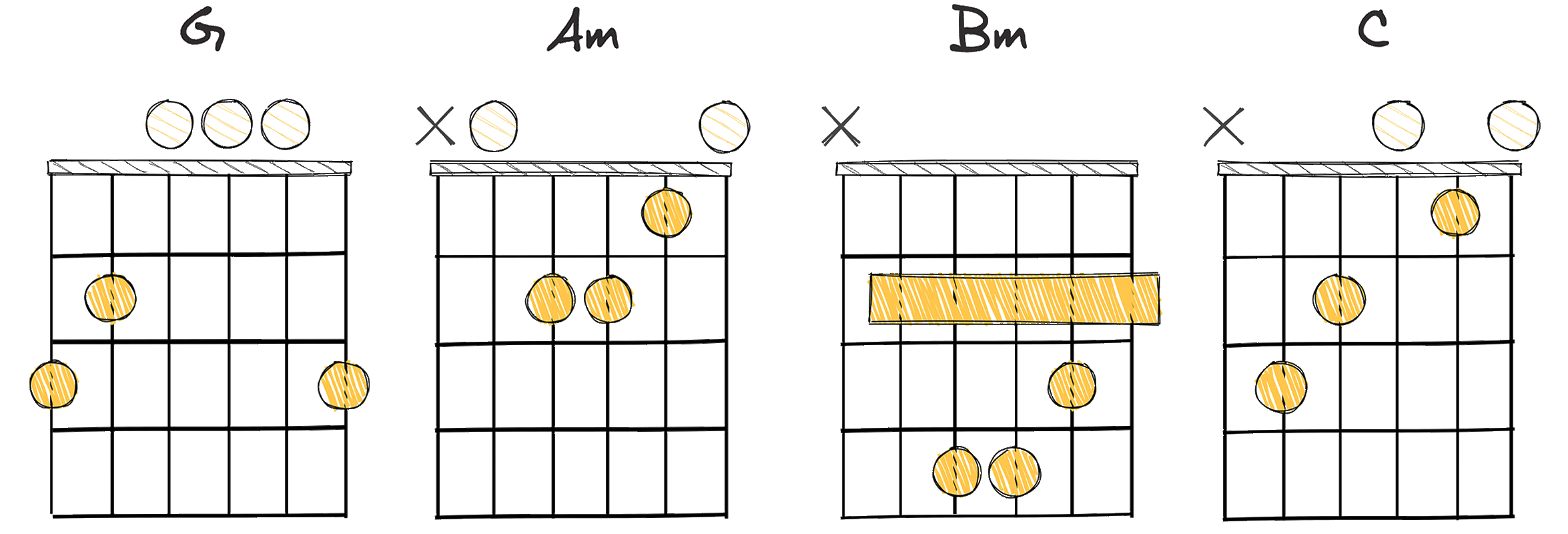
Among the many chord progressions available to musicians, I-ii-iii-IV, or 1-2-3-4, has an important role in creating lively and cheerful compositions.
This progression, easy to play and with a straightforward structure, has been essential for many songs aiming to uplift the listener’s spirit.
Known for its inherent simplicity, the 1-2-3-4 progression is especially appealing for beginners due to its conventional progression of tones.
Despite its simplicity, the 1-2-3-4 progression offers a rich opportunity for emotional and musical expression.
It aids musicians in expressing positive emotions effectively, thus resulting in many hit songs over the years.
Further enhancing the creative value of this progression is its versatility across different genres, from pop to rock and even blues.
This progression is also well represented in the chords G-Am-Bm-C in the key of G major.
Songs using these specific chords offer a cheerful resonance which creates a heartening and uplifting effect.
The unique combination of these four consecutive chords has been known to create a flowing rhythm, again contributing to the creation of happy tunes.
Consequently, the 1-2-3-4 progression has been ubiquitous across various eras of music, forming the backbone of countless cheerful tunes.
From historical folk songs to modern pop hits, this progression has been a favorite among composers aiming to convey happiness, joy, and uplifting moods.
Despite their simplistic nature, these three chords in progression have the power to evoke intense emotions and build a strong musical atmosphere.
Equally remarkable is the fact that this easy to play progression supports both vocal and instrumental melodies, exhibiting its versatility in a multitude of musical contexts.
I-iii-IV-V (1-3-4-5)
A joyful journey through uplifting and dynamic chord transitions.
This I-iii-IV-V chord progression, also known as 1-3-4-5, creates a light, buoyant mood in music, frequently used in upbeat genres thanks to its ability to elicit feelings of happiness. The progression’s smooth transition from the tonic to the mediant, followed by the subdominant and dominant, culminates in a pleasant resolution, lifting the spirit of the song and the listener.
- Difficulty: Easy
- Example: G – Bm – C – D (Key of G major)
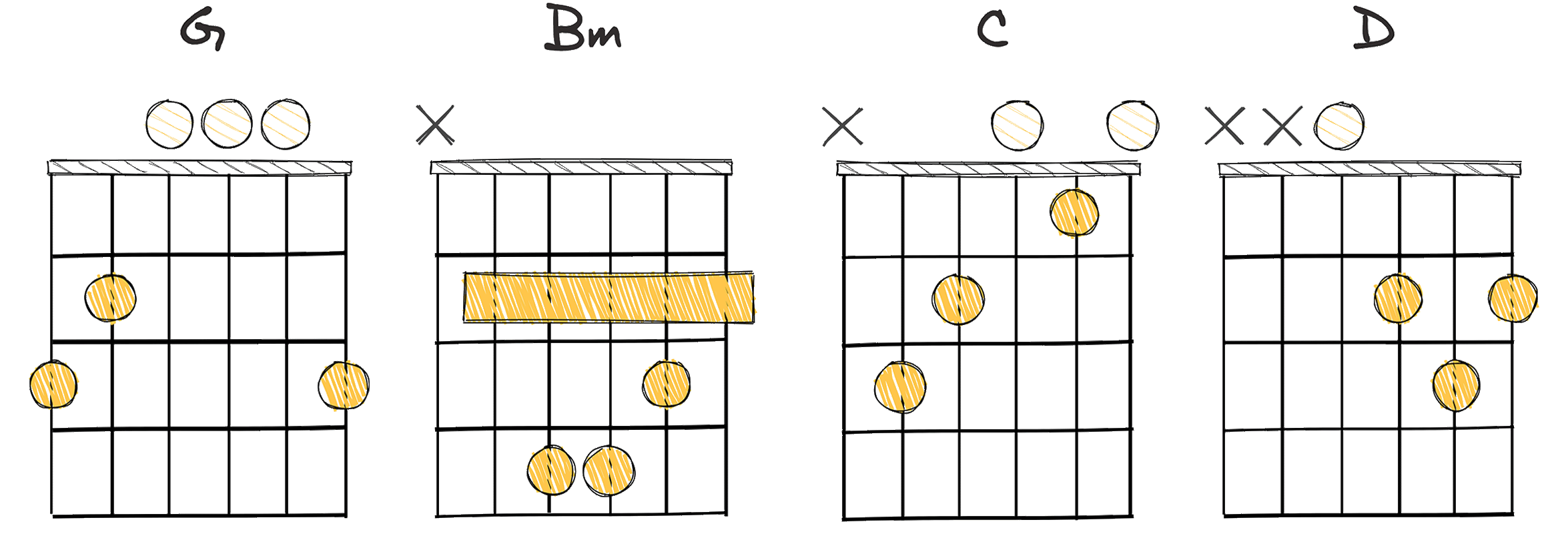
The I-iii-IV-V chord progression is an uplifting and simple chord progression that has been used in various genres of music to create a happy and energetic mood.
Of course, its simplicity does not mean it lacks depth or versatility, on the contrary, it carries a unique trait that allows it to be used in a plethora of different contexts.
This progression’s blend of major chords provides a cheerful and positive sound, making it a go-to choice for composers seeking to invoke a happy or upbeat vibe.
Also, due to its simplicity, the progression is easy to play – an attribute that makes it an excellent starter progression for starters.
Historically, it has been a progression of choice for many popular music artists, fully embodying the happy vibe that is at the heart of most pop music.
The immense widespread use of the I-iii-IV-V progression is very likely due to its ability to effortlessly emit a blissful vibe.
The previous statement is supported by the fact that the I-iii-IV-V progression continues to be extensively used across different music genres, indicating its successful conveyance of a universally adored, cheerful feeling.
Another interesting point is that this progression, as represented in the key of G Major (G – Bm – C – D), can be seen in many popular songs due to its simple structure and catchy tune.
This progression’s chord sequence follows a straightforward pattern of I – III – IV – V that inherently allows for an energetic rhythm and a vibrant musical feel.
Given its wide spectrum of applications in various musical styles—from pop to rock to folk—it’s no wonder that it continues to be one of the favored progressions amongst songwriters and musicians.
Last but not least, the I-iii-IV-V progression, due to its simplicity and vibrancy, holds a significant place in teaching materials and music theory books targeted at aspiring musicians.
These factors make it evident that the I-iii-IV-V progression is a classic chord progression in music, an omnipresent entity in the world of happy and uplifting music.
II-IV-V-II (2-4-5-2)
A lively, jubilant progression evoking cheerful, uplifting musical moods.
The II-IV-V-II chord progression brings a jovial and energetic feel to music, producing an instant mood booster. This major key progression, used extensively in pop and jazz music, creates an uplifting sound due to the resolved tension between the chords.
- Difficulty: Easy
- Example: E – G – A – E (Key of D major)
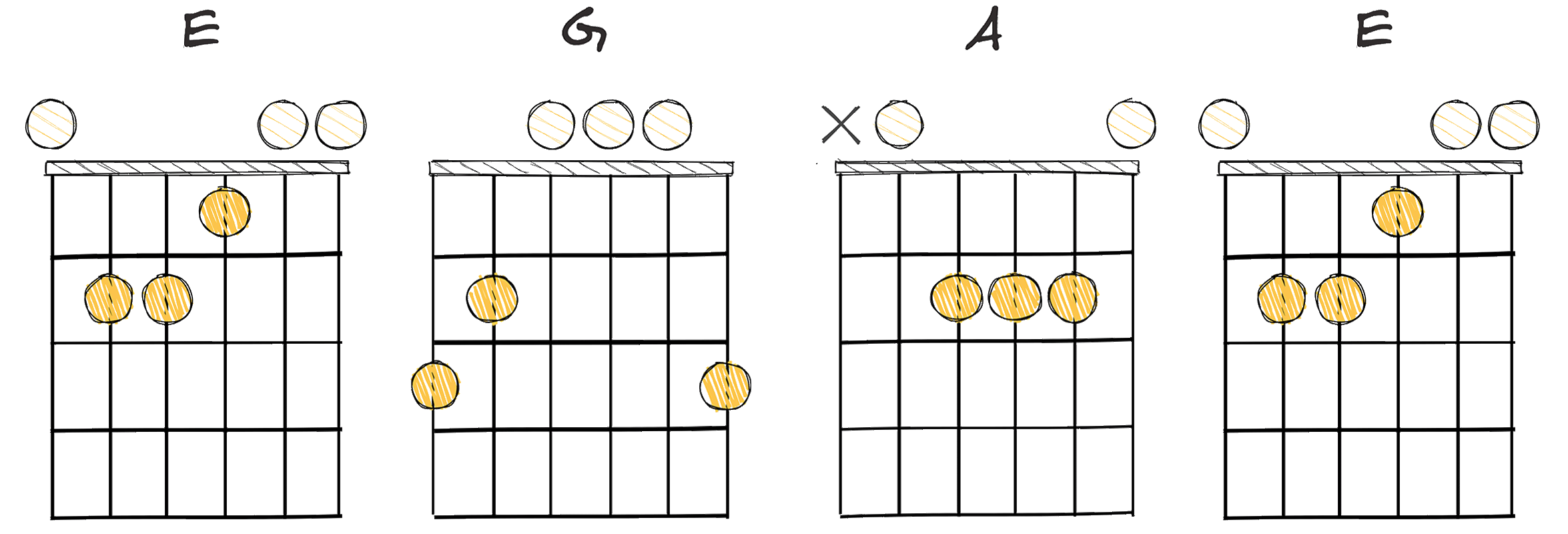
Understanding the II-IV-V-II (2-4-5-2) progression may seem overwhelming at first, but in reality, it’s a very easy chord progression to master.
A prominent part of music history, this progression has been a building block for countless successful songs over the decades.
Requiring just four chords, it presents a beautiful resolution that politely maintains the flow of the music without being too pushy.
In essence, it’s a chord progression that possesses an inherent joy, fostering an uplifting mood throughout any song it graces.
The flow of harmony in this progression typically starts off strong, maintains an upbeat vibe in the middle, and finally concludes with a gentle closure that allows the listener to anticipate the next chord.
The choice of D major as the key certainly added to the positive energy of the song, ensuring it resonates deeply with the listeners.
Playing the chords back-to-back allows for an easy continuity, building up anticipation with each subsequent chord and letting it resolve with the change from the V chord back to II.
What the progression does exceptionally well is it manages to keep the mood of the song upbeat without being overbearing.
Despite being straightforward, the II-IV-V-II progression creates enough of a melodic structure that can follow any lyric’s narrative and emotion.
Therefore, it’s a useful tool for any songwriter wanting to evoke a feeling of joy, hope or positivity in their work.
This progression’s adaptability is also something to admire, working well in a wide range of musical styles from pop to country, reggae, and beyond.
It’s easy to see why the II-IV-V-II chord progression, in its beautiful simplicity, continues to be favoured by songwriters looking to impart a sense of uplifting calm and happiness.
Its universally appealing sound paired with the easy playability, explains its ubiquitous presence in feel-good songwriting.
Whether you’re a novice musician or experienced songwriter, this progression can play a pivotal role in bringing an infectious and uplifting energy to your music.
Even as we explore other chord progressions, the II-IV-V-II chord progression’s happy and soothing character is a quality to remember and take inspiration from.
IV-V-I (4-5-1)
The IV-V-I progression: the musical recipe for ultimate joyfulness.
The IV-V-I (4-5-1) progression is a sequence of chords that is known for its bright and uplifting nature, often employed in various types of music for creating a joyful vibe. It typically starts on the subdominant (IV), moves to the dominant (V), and resolves on the tonic (I), providing a strong sense of resolution and positivity.
- Difficulty: Easy
- Example: F – G – C (Key of C major)
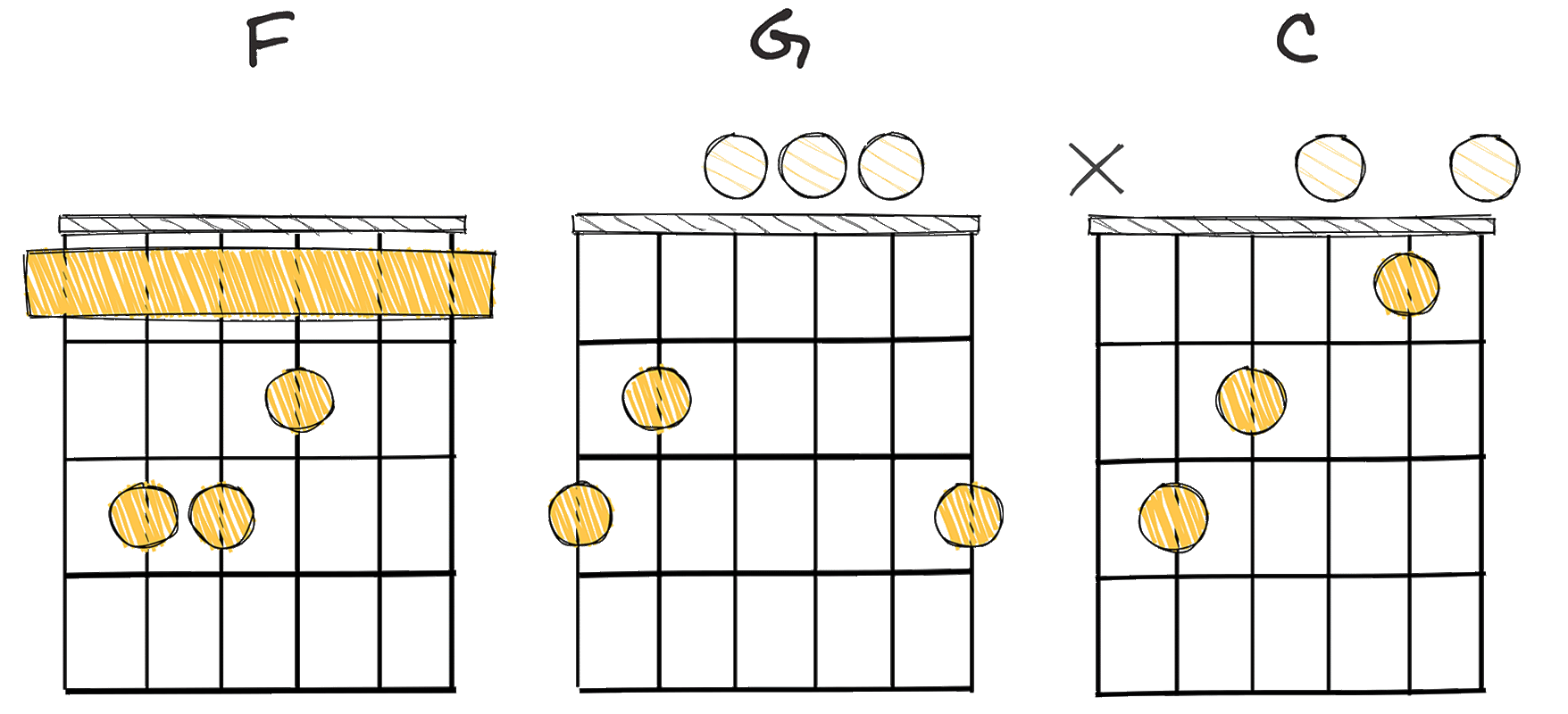
Chord progressions are an integral part of music, governing the way a song unfolds over time.
A particularly pleasing and widely used chord progression is the IV-V-I (4-5-1).
The essence of this three-chord progression lies in both its simplicity and the satisfying resolution it provides.
The IV-V-I progression is intrinsically ingrained in the Western musical tradition, a testament to its power to evoke emotion and its intrinsically pleasing tonal structure.
Indeed, the IV-V-I progression is so deeply embedded in our collective musical psyche that it has been exploited across a wide range of music styles.
Whether it’s rock, pop, jazz, or blues, likely you’ve heard and appreciated this progression, often without realizing it.
Tracing back to the history, the IV-V-I chord progression has been enriching our musical experiences for centuries.
This progression’s widespread use, dating back to the Baroque Era, stands as clear evidence of its universal appeal and enduring power.
When it comes to satisfaction and fulfillment in music, particularly in popular Western music, the IV-V-I progression is the ‘go-to’ choice
This progression’s strength lies in its ability to establish a feeling of stability and then venture away, creating tension, only to resolve it spectacularly by returning to the original chord.
This balance between tension and resolution is a key aspect of what makes the IV-V-I progression so satisfying to the human ear.
Learning to play the IV-V-I progression on a musical instrument is straightforward, making it a great choice for beginners.
This ease of play further popularizes this progression among musicians young and old.
The pattern, such as ‘F-G-C’ in the key of C major, can be transposed into any key, thereby making it a versatile tool in a songwriter’s toolkit.
Hence, the IV-V-I progression is a staple that every musician or songwriter should be familiar with.
ii-vi-V (2-6-5)
A fun, uplifting progression, adding a bright tone to melodies.
The ii-vi-V (2-6-5) chord progression is bright and uplifting, adding a joyful and optimistic feel to any piece of music. It begins with the supertonic, moves to the submediant, and finally lands on the dominant, creating a harmonious and cheerful mood that is sure to inspire a sense of positivity among listeners.
- Difficulty: Easy
- Example: Em – Bm – A (Key of D major)
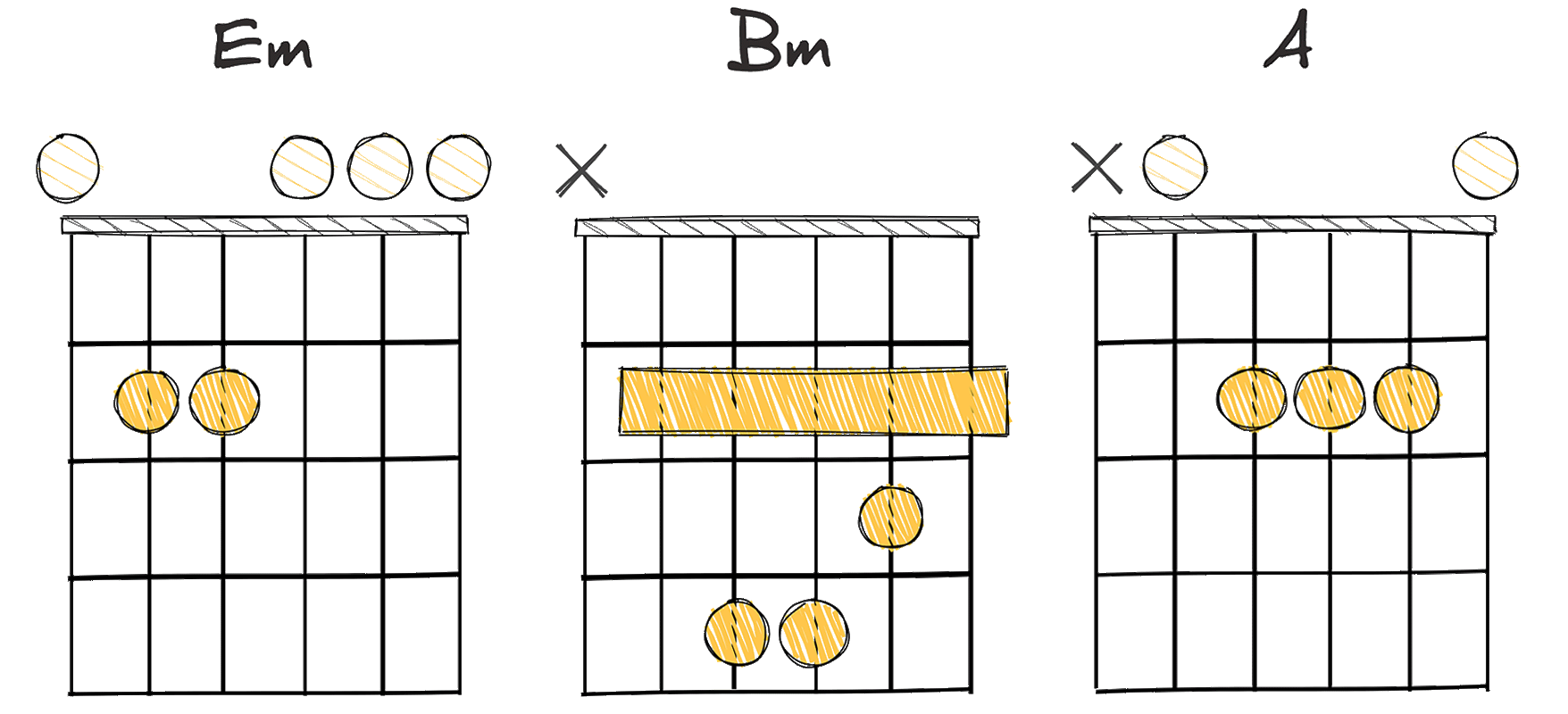
The ii-vi-V (2-6-5) chord progression is a remarkable harmonic pattern that has been utilized in various music genres for centuries.
It’s commonly recognized for offering a sunny, uplifting auditory sensation.
This chord progression holds a prominent spot in the history of music composition.
The origins of ii-vi-V can be traced back to the classical period, though it gained significant popularity in the 20th century, featuring in numerous jazz standards and pop ballads.
It’s renowned for its capacity to transport listeners from a state of tension delivered by the minor sixth chord to a cheerful resolve facilitated by the dominant fifth.
Its intriguingly bright tonality contributes to its usage in numerous musical pieces to convey emotions of happiness and delight.
You might be surprised to learn that the ii-vi-V progression is quite easy to play.
This characteristic makes it an endearing choice for both novice and pro musicians.
This progression, despite its simplicity, can foster a profound sense of musical satisfaction.
The transition from the second to the sixth, and subsequently to the fifth chord, can craft a pleasing auditory journey, notably amplifying a song’s sonic appeal.
It’s interesting to consider the various interpretations and implementations of the ii-vi-V progression.
Musicians often use it to construct verses or choruses in their compositions, further contributing to its ubiquity in the musical realm.
Moreover, the versatility of the ii-vi-V progression enables its usage in various genres – from rock to pop, blues to jazz, and more; it’s seemingly limitless in its potential to inspire, uplift, and enchant.
As you continue to explore the vibrant landscape of chord progressions, you’ll undeniably encounter the ii-vi-V sequence many more times.
It’s easy playability and delightful tonality mark it as a staple in many musical genres.
Remember, though, every chord progression, just like every song, is a means of artistic expression and there are no hard and fast rules in terms of their usage.
I-ii-IV-V (1-2-4-5)
A cheerful progression invoking an uplifting, light-hearted musical vibe.
The I-ii-IV-V chord progression is an energetic and bright sequence that instantly brings a joyful and uplifting mood to any music composition. With its roots in pop and jazz, this progression’s buoyant nature exudes an infectious positivity, capable of perfectly encapsulating feelings of happiness and good vibes in music.
- Difficulty: Easy
- Example: D – Em – G – A (Key of D Major)
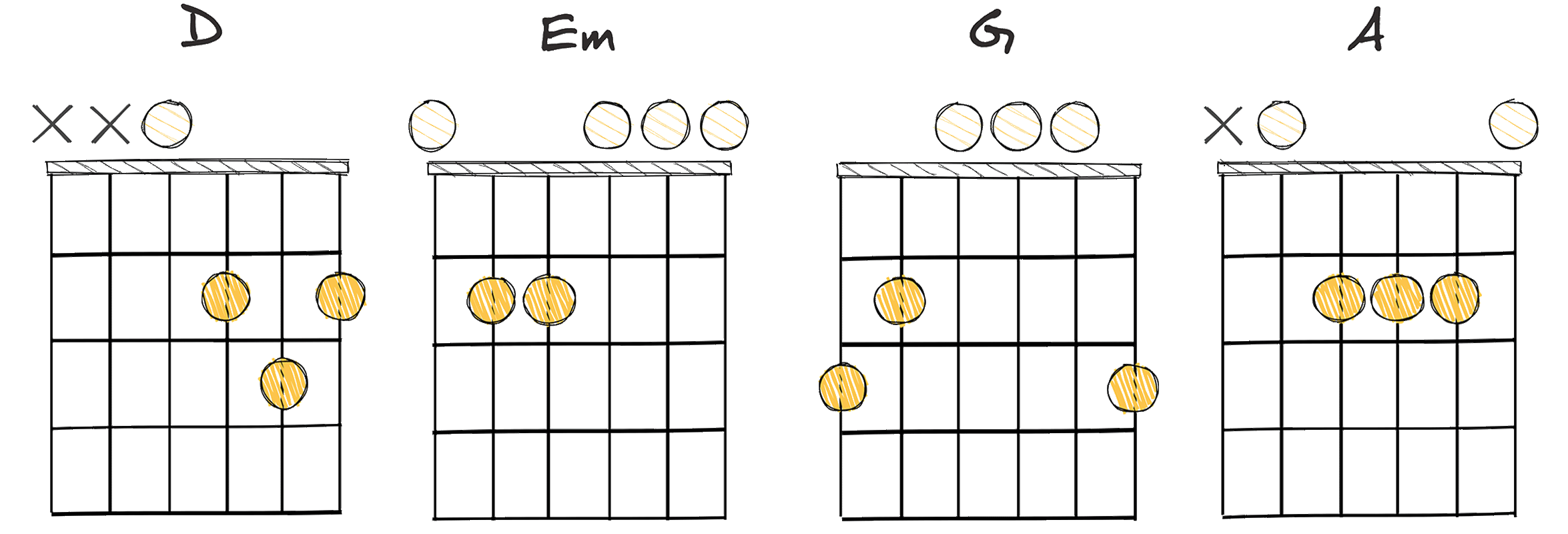
When it comes to creating a sense of happiness in music, happy chord progressions play an essential role.
Chord progressions can be considered as a series of musical chords played in sequence.
One such progression that has consistently elicited positive emotions is the I-ii-IV-V(1-2-4-5) progression.
This chord progression, easy to play and universally endearing, is marked by its simplistic structure and uplifting influence.
Creating a pleasing harmony, this chord progression contributes to the song’s overall feel-good vibe.
Professional musicians all across the globe have used this progression due to its ease and clear effect on the listeners’ mood.
The sheer beauty of this progression is its ability to evoke happiness, regardless of the genre it’s used in.
Although it may seem simple, the I-ii-IV-V (1-2-4-5) progression has been popular for many years, perhaps because of its interesting history in music progression,
Speaking of history, it’s fascinating to note that this pattern can be traced back to classical music and gradually earned its place in contemporary music.
Moreover, its widespread use is also a testament to its flexibility and adaptability across a range of musical eras and styles.
The effective use of this chord progression serves as an inspiration for budding musicians, establishing a foundation on which they can build their own musical dreams.
V-IV-I (5-4-1)
This progression radiates joyful resolution and triumphant satisfaction.
The V-IV-I chord progression is a classic sequence in music that produces a cheery and upbeat effect, successfully uplifting listeners’ spirits. Dominant in nature, this progression ends on a satisfying and resolved note, often used in various genres for its joyful and comforting sound.
- Difficulty: Easy
- Example: D – C – G (Key of G major)
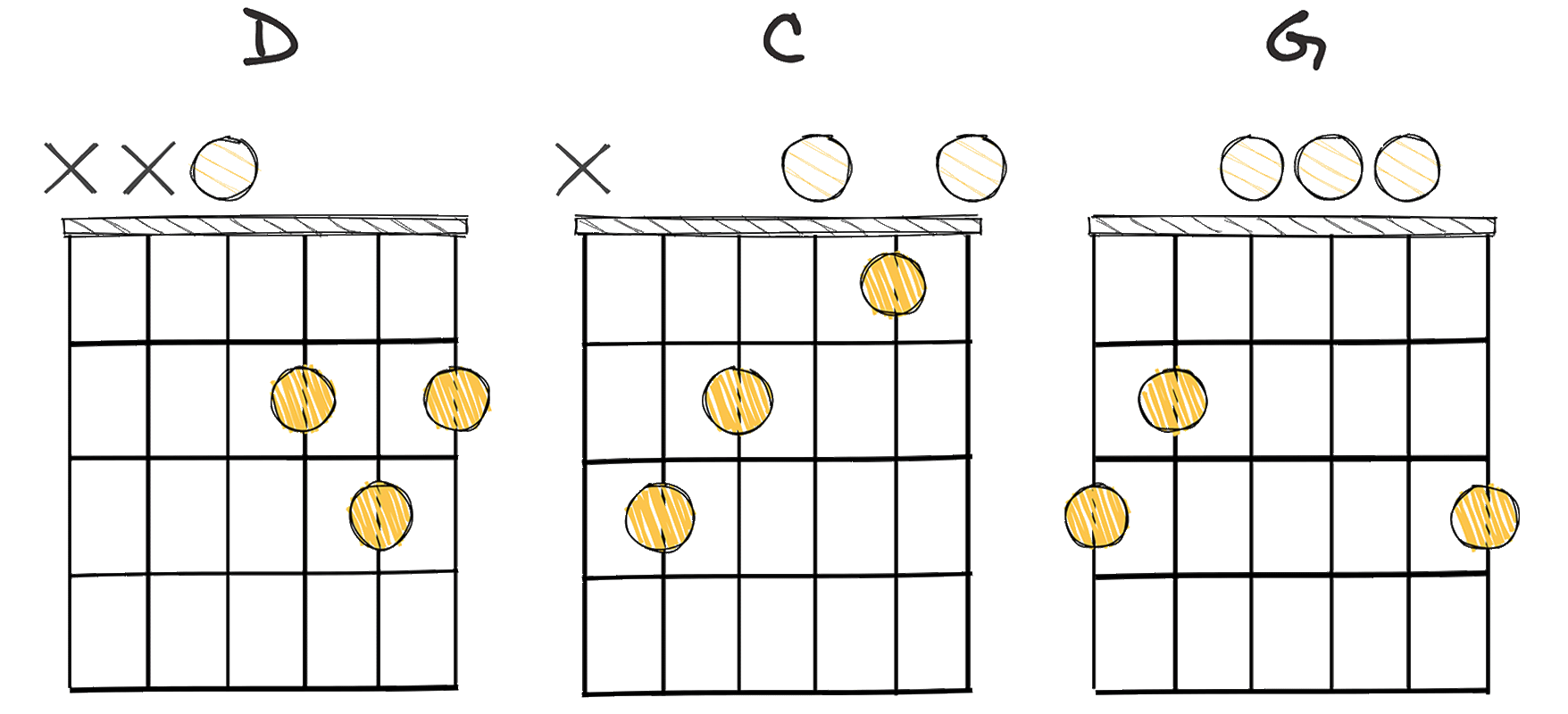
Section 13 explores the V-IV-I chord progression, known for creating feelings of happiness and resolution in music.
This commonly used sequence stimulates emotional responses in listeners, making them feel joyful and uplifted.
One of the reasons this progression is popular is due to its historical prevalence.
Dating back to classical compositions, this progression has a timeless appeal that transcends genres and styles.
This progression has a fascinating ability to create a sense of chordal ‘gravity’, leading naturally from the fifth chord (V) to the fourth chord (IV), and finally resolving with a satisfying return to the first chord (I).
This ‘gravity’ is a musical phenomenon that enhances the emotional impact of songs.
It leads listeners on a journey that feels inherently right and fulfilling, bridging notes and harmonies in a way that resonates on a profound level.
Apart from this, the V-IV-I progression is easy to play, making it an excellent choice for musicians of all skill levels.
Even beginners will find that these chords fall naturally under the fingers, making it as delightful to play as it is to hear.
Within the key of G major, for example, this progression would correspond to the chords D – C – G.
Furthermore, the progression functions well in different musical contexts, from pop to rock, country to blues, jazz to classical.
Its simplicity and versatility contribute to its widespread use across various styles.
Professionally, being able to understand and utilize this chord progression will significantly benefit composers and performers alike.
It is a tool that can be used to create a satisfying and effective musical narrative.
Importantly, the V-IV-I progression is not merely a formula, but a flexible template that can be tailored to suit a musician’s creative intention.
It can be used as-is for a traditional, comforting sound, or tweaked with additions, substitutions, or inversions for a more complex or unique effect.
The V-IV-I progression is a simple yet potent musical device that has the power to create happy, uplifting music that resonates with listeners.
ii-V-IV-I (2-5-4-1)
This 2-5-4-1 sequence offers a joyful resolution uplifting your soul.
The ii-V-IV-I is a popular chord progression known for its upbeat, cheerful, and uplifting sound that stirs listener’s emotions positively. It smoothly flows from one chord to another with a resolution that provides a satisfying sense of completion, creating a joyful musical atmosphere that infuses a sense of happiness and positivity.
- Difficulty: Easy
- Example: Em – A – G – D (Key of D Major)
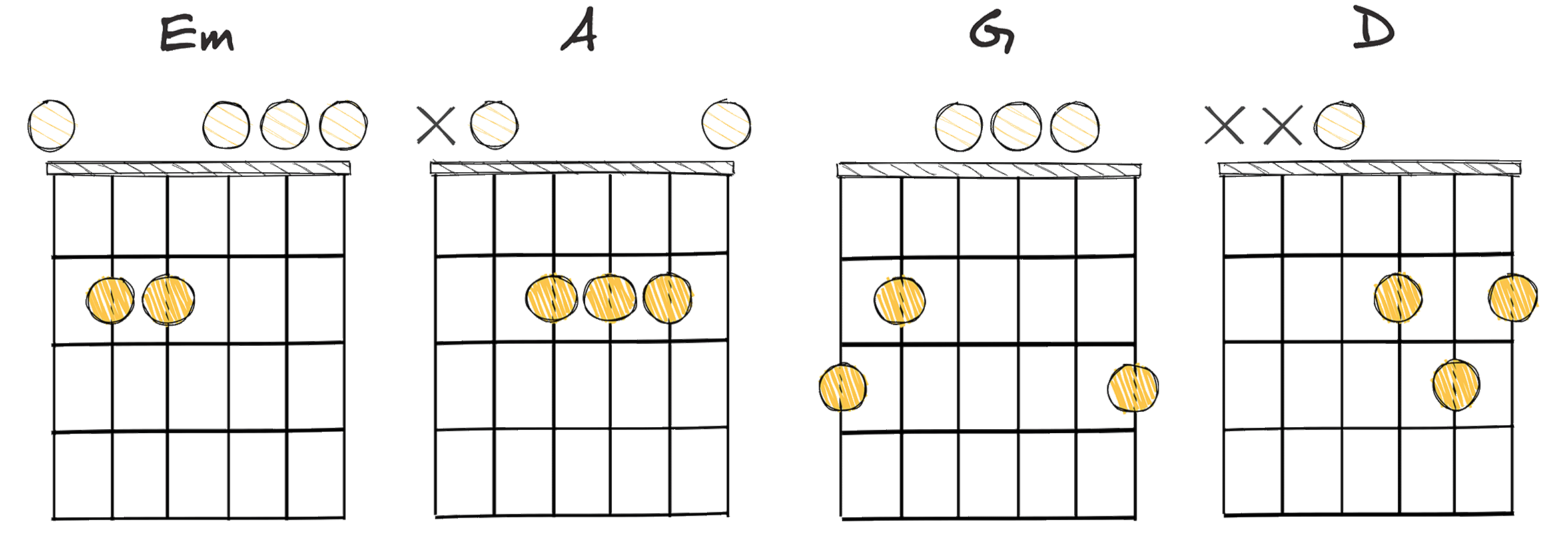
The chord progression ii-V-IV-I (2-5-4-1) is a simple yet elegant sequence that has been central to countless uplifting songs throughout music history.
This progression is quite popular in jazz music but can be found in any genre, providing a sense of resolution and satisfaction to the listeners.
It has a rich history and is considered a classic tool by composers and songwriters for generating a positive, uplifting vibe in their work.
The ii-V-IV-I (2-5-4-1) progression is seen as a foundation in many musical genres and is particularly prevalent in pop, rock, gospel and country music.
Given its ubiquitous presence, aspiring musicians often find this progression relatively easy to play.
Bringing this further into context, let’s consider the key of D Major and the chords Em – A – G – D.
Here the second (Em), fifth (A), fourth (G) and first (D) chords correspond to that specific ii-V-IV-I sequence.
Early exposure to this sequence can be a stepping stone for budding musicians, allowing them to explore complex harmonies and patterns.
However, it’s not only limited to “feel-good” music, it has made its way into heart-wrenching ballads and even rock anthems, thereby testifying its versatility across different music styles.
It’s interesting to note that the order of chords visibly impacts the mood of the piece, so while the order ii-V-IV-I is generally cheerful, modifying it may change the tone dramatically.
This is a clear showcase of how chord progressions like ii-V-IV-I can be used as building blocks to construct the mood and feel of a song..
vi-V-IV-I (6-5-4-1)
A joyful journey guiding the musical spirit from tension to resolution.
The vi-V-IV-I (6-5-4-1) progression is a popular and commonly used progression in music, especially in pop and rock genres. This upbeat progression, often associated with uplifting and joyous tracks, tends to create a positive and happy atmosphere, making it an effective tool to lift the listener’s mood.
- Difficulty: Easy
- Example: F#m – E – D – A (Key of A major)
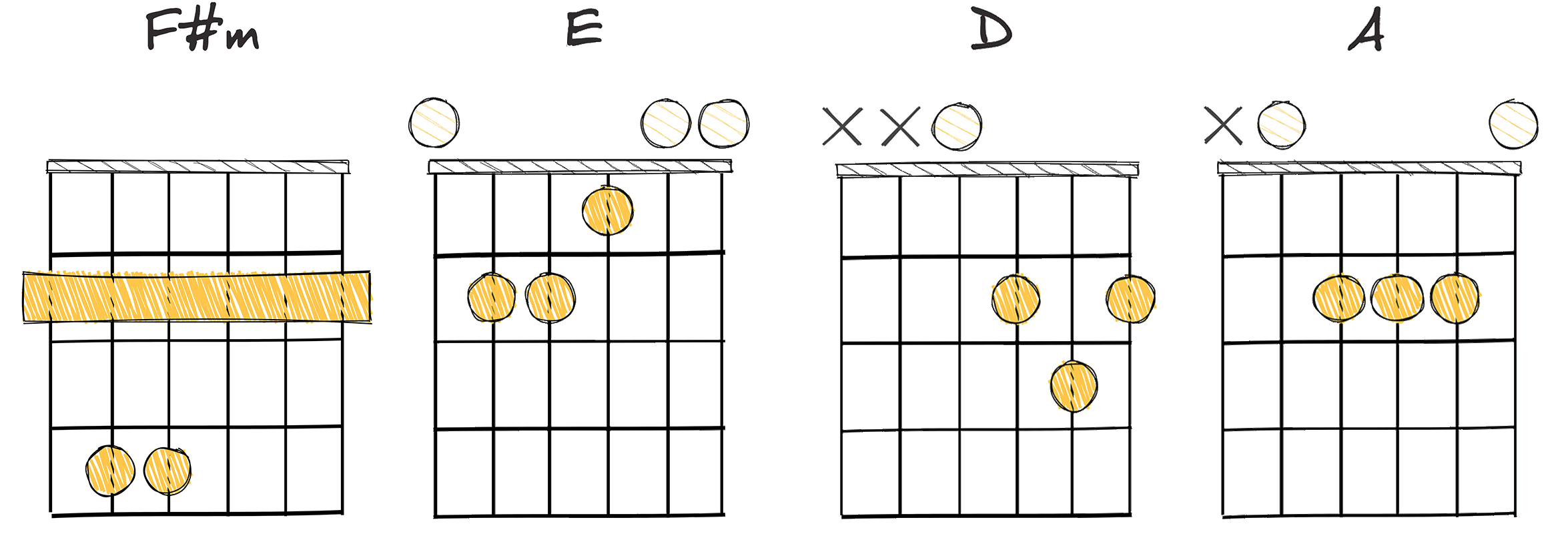
In the vast landscape of musical harmony, the chord progression of vi-V-IV-I (6-5-4-1) shines as a particularly uplifting and inspiring sequence.
The vi-V-IV-I (6-5-4-1) progression has an Easy-to-play nature, welcomed by both experienced and novice musicians.
The progression crafts a conducive environment for musical experimentation, allowing countless artistic flavors and colors to be painted through different inversions, rhythms, and dynamics.
Comprehending the structure of this progression is a significant stepping stone in understanding the language of harmony.
It consists of the sixth, fifth, fourth, and first chords (vi-V-IV-I) respective to the key it is performed in.
If you examine the key of A Major, for instance, the progression would utilize the chords of F# minor, E Major, D Major, and A Major (F#m – E – D – A).
This particular string of chords carries a certain magical musical potency, capable of elevating your spirits instantly.
When we dig into musical history, it becomes evident how noteworthy this progression truly is.
Its origins can be traced back to the Baroque period, frequently appearing in the works of composers like Bach and Handel, then progressing through the ages to the Romantic era, Jazz age, and the dawn of Rock ‘n’ Roll, it has proven its timeless value.
Notably, the progression’s sonority is characterized by its perfect cadence, moving from the dominant (V) to the tonic (I), forming a musically satisfying resolution that gives a sense of conclusion to a phrase.
However, the presence of the VI chord before the cadential progression adds a delightful twist, delaying the resolution and intensifying the eventual return to the tonic chord.
Additionally, this progression’s bold and upbeat energy supports a wide range of melodies, enabling the vocalist or lead instrument to explore various expressive contours and motifs, contributing to an engaging and dynamic musical experience.
A keen listener would also appreciate the harmonic colors and emotional landscapes the progression paints.
From the melancholic allure of the sixth chord to the tension of the fifth, the placidity of the fourth, and the homecoming resolve of the first chord, the listener is taken on an emotional roller coaster ride, shaping a sublime auditory story within their hearts.
The appeal of the vi-V-IV-I progression indeed reaches beyond its mere musical charm, influencing the collective consciousness of listeners, invoking positive emotions, and becoming an integral part of our musical heritage.
Its lasting legacy is a testament to its emotive power and creative versatility.
Among all its virtues, however, its most crucial contribution lies in its ability to infuse joy into any piece it graces.
Crafting smiles, melting hearts and truly living up to its reputation as a ‘happy’ progression.
To quote the immortal words of Leonard Cohen, it truly seems to be a “secret chord that pleased the Lord”.
Regardless of whether you’re a seasoned composer, an aspiring musician, or a hobbyist, the vi-V-IV-I (6-5-4-1) progression serves as a wonderful musical boon to your arsenal, ensuring your compositions and performances always bring a dash of sunshine and happiness into the world.
I-vi-IV-V (1-6-4-5)
A joyful journey through chords that radiates a feel-good vibe.
The I-vi-IV-V chord progression is a sequence of chords that is often used in music due to its uplifting, optimistic, and happy tones. This progression involves starting on the first (I) chord, moving to the sixth (VI), then the fourth (IV), and finally the fifth (V), creating a lively and bright rhythm that can raise the spirits of both the musicians playing it and the listeners.
- Difficulty: Easy
- Example: G – Em – C – D (Key of G major)
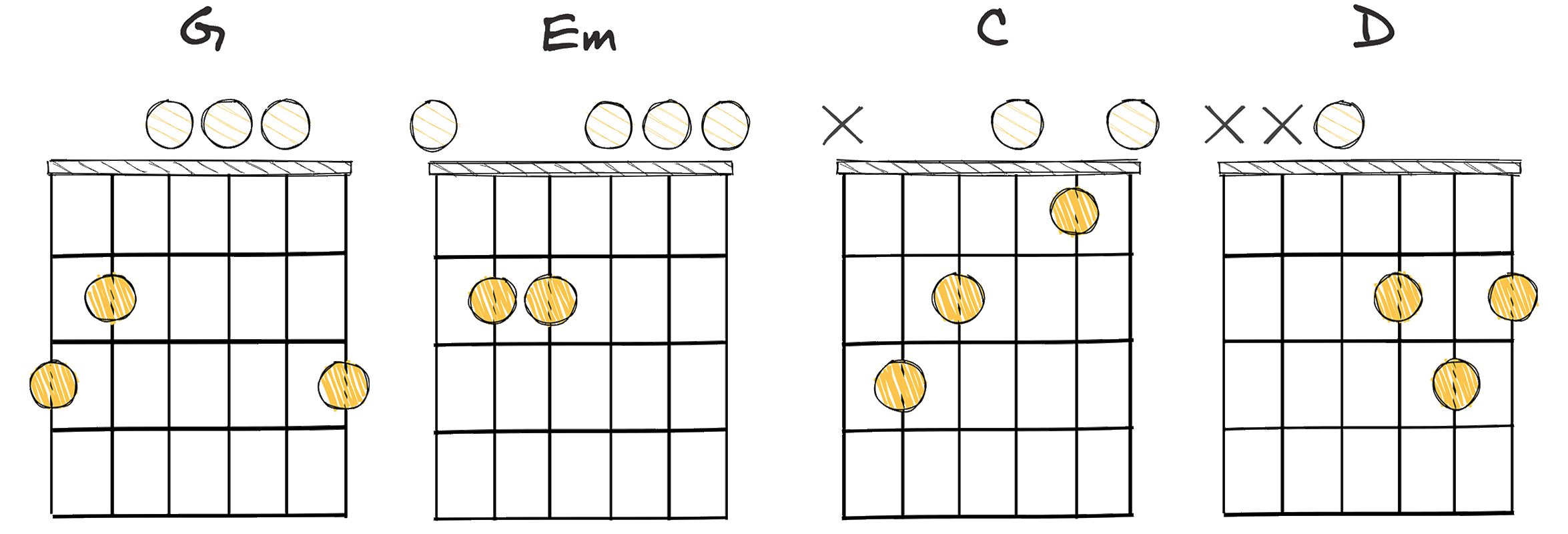
One popular chord progression that resonates with joyous and uplifting energy is the I-vi-IV-V progression.
This progression is popular within the musical industry due to its seamless transition from one chord to the next, giving a song an overall happy and uplifting feel.
The I-vi-IV-V progression is also known as the 50s progression. This is because it was popular in a wide variety of 1950s pop and doo-wop hits.
Its use was not only limited to the 50s, but it has continued to influence music throughout the years, making it a tried-and-true progression.
Notably, the I-vi-IV-V progression is simple and easy to play.
This is perhaps one reason for its popularity.
Because of its simplicity, it allows for mass appeal and accessibility to both musicians and audiences alike.
Due to the progression being easy to play, it leaves ample room for the artist to focus on melody, lyrics, and overall composition.
The four-chord cycle allows for a flowy, smooth, and merry bounce that works well with a variety of genres, even outside of pop music.
The I-vi-IV-V progression showcases how combinations of chords can greatly impact the mood of a song, making it a go-to choice for many composers interested in creating uplifting and happy songs.
Learning this progression and incorporating it into your music is an excellent way to introduce a bright, feel-good spirit into your musical composition.
Quite simply, the I-vi-IV-V progression is one of those classic elements that never goes out of style.
vi-II-V-I (6-2-5-1)
Jazz-inspired progression exuding joy and lifting listener’s spirits.
The vi-II-V-I (6-2-5-1) chord progression is a fundamental staple in many genres of music, often used to create an uplifting and cheerful sound. It is recognized for its cyclic movement, producing a resonant harmonic framework that can bring joy and positivity in any musical piece.
- Difficulty: Easy
- Example: F#m – B – E – A (Key of A major)
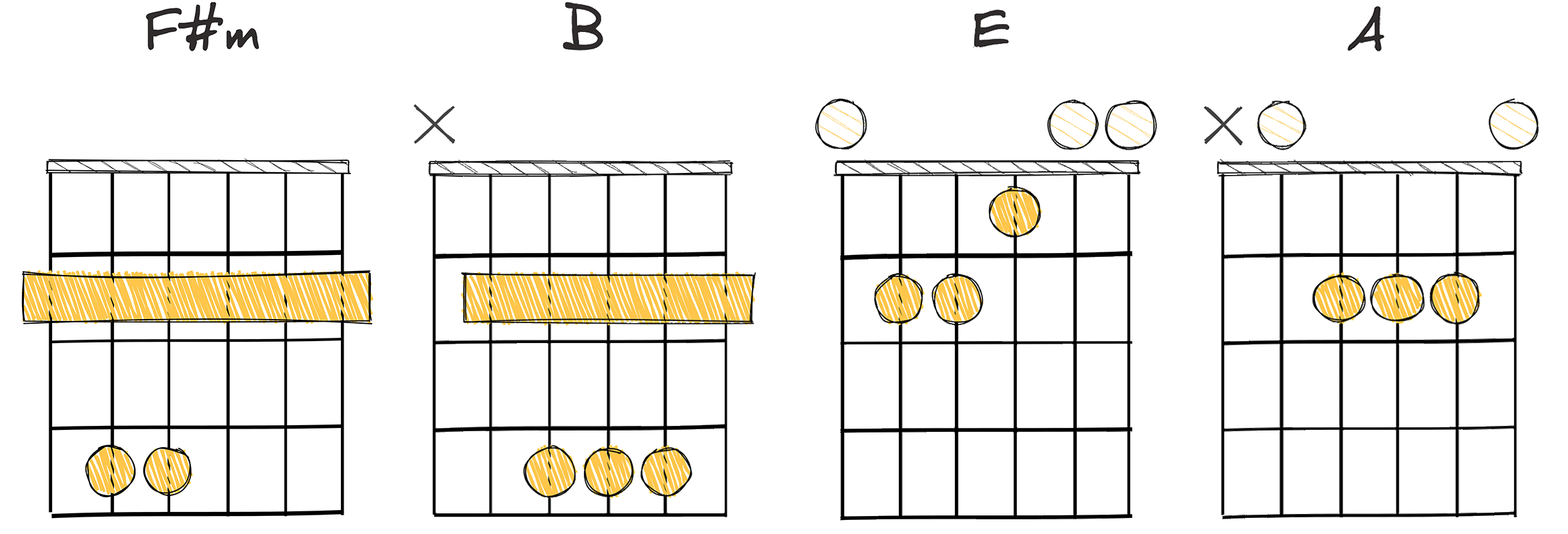
The chord progression vi-II-V-I (6-2-5-1), is deeply embedded in music history and widely admired for its practicality and simplicity.
Originating centuries ago, this harmonic pattern has its roots in European classical music and has been adopted by countless composers and songwriters in every conceivable genre, from baroque to blues to rock and roll.
One of the charms of this progression is its ease of execution, making it a firm favorite among musicians of all levels of expertise.
The chords used in vi-II-V-I (6-2-5-1) are relatively simple to play and they flow smoothly from one to the next, reaching a satisfying resolution when returning to the tonic or root chord.
Equally important to ease of playability is the emotional impact of this progression.
With its ascending motion and open-ended resolution, this chord progression creates a feeling of optimism and uplift, a musical journey from minor to major, from tension to release, from doubt to certainty.
Indeed, the uplift you experience when listening to a song containing this chord progression can be truly spirit-raising.
Even though each chord is simple by itself, their combination and the transition from one to the next can drastically alter your emotional state.
For musicians learning to play chords, an example of vi-ii-V-I (6-2-5-1) in the key of A Major could be F#m – B – E – A.
But remember, these are only the basic chords.
This progression offers countless possibilities for personal interpretation and embellishment.
As a musician, one may use this progression as a foundation and employ different chord voicings, extensions, and alterations to make it their own, thereby offering a fresh take on a classic musical theme.
The vi-II-V-I represents possibility, offering a musical platform for creativity while speaking to the universal human experience of struggle and victory.
I-V-IV-ii (1-5-4-2)
A bright, buoyant progression chases away blues and invokes joy.
The I-V-IV-ii chord progression is a jubilant combination that produces an uplifting and positive vibe in the music, perfect for inducing an optimistic feel. Consisting of the first, fifth, fourth, and second chords in the major scale, this progression exudes a cheerful and light-hearted tone, widely used in numerous genres for its blissful sonic output.
- Difficulty: Easy
- Example: D – G – A – Em (Key of D major)
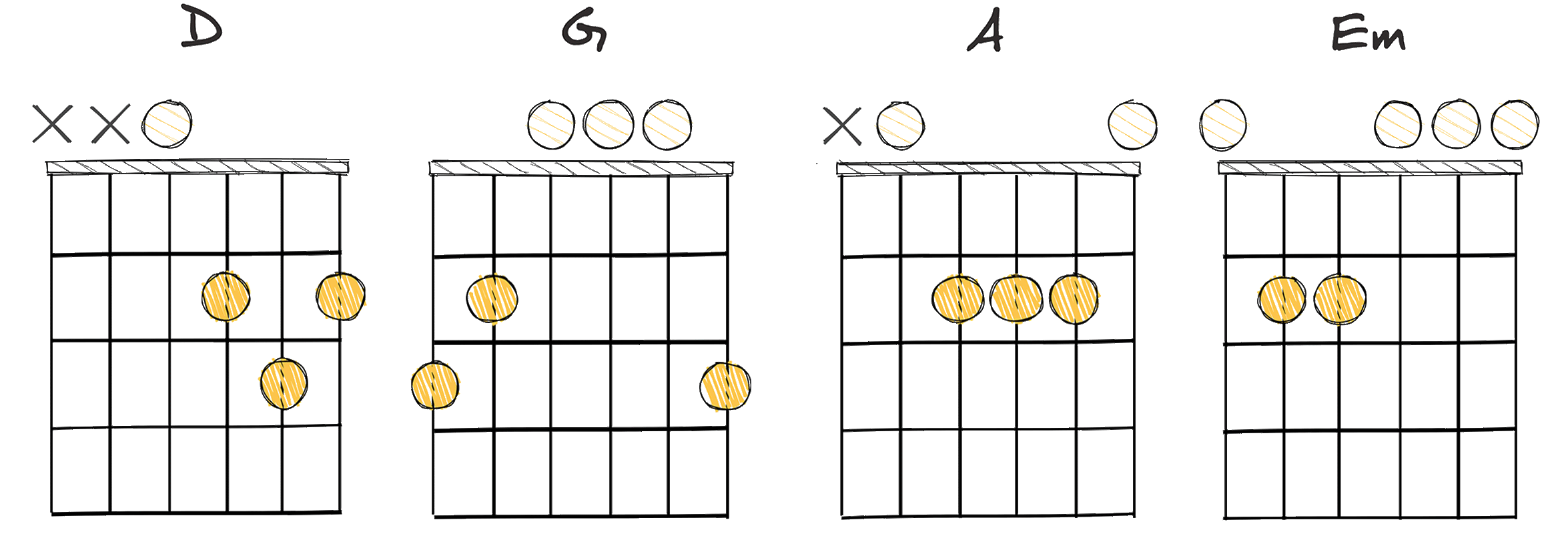
One of the most uplifting and joyous chord progressions that can transcend your spirit to a state of exhilaration is the I-V-IV-ii progression, or 1-5-4-2.
This chord progression, with its uplifting spirit, can be prominently found in pop or rock genres, delivering a rich and cheerful vibe that is infectious.
The origin of the I-V-IV-ii progression dates back to the classical era, yet has found a renewed life in contemporary music, thereby creating a harmonious blend of classical and modern.
Ranked as an intermediate-level progression, this chord sequence gives musicians an opportunity to explore the grandeur of major chords, wherein the second chord adds a touch of surprise and novelty to the composition.
Let’s translate this to a concrete example – If we choose the key of D Major, the I-V-IV-ii progression transforms into D-G-A-Em chords.
Using I-V-IV-ii progression can help in creating songs with a sense of forward motion and unresolved sensation, which implicitly urges the listener to anticipate what comes next.
In a broader context, the exploration of such profound chord progressions provides musicians an avenue to express their creativity, while also impacting and enriching the listeners’ musical journey.
The fluidity created by the I-V-IV-ii progression helps in creating dynamic mood swings within a song, maintaining a sense of surprise and sustaining the engagement of listeners.
Given its innate ability to evoke a range of emotions, the understanding and application of the I-V-IV-ii progression, therefore, serves as an empowering tool for any musician.
vi-IV-V-I (6-4-5-1)
A joyful journey resonating bliss through foundational musical harmony.
The vi-IV-V-I chord progression, also known as 6-4-5-1, is a popular harmonic pattern in music that creates an uplifting and joyful sound. From pop to rock to classical music, this progression invokes a sense of resolution and positivity, perfect for relaying a happy or triumphant mood in your compositions.
- Difficulty: Easy
- Example: Em – C – D – G (Key of G major)
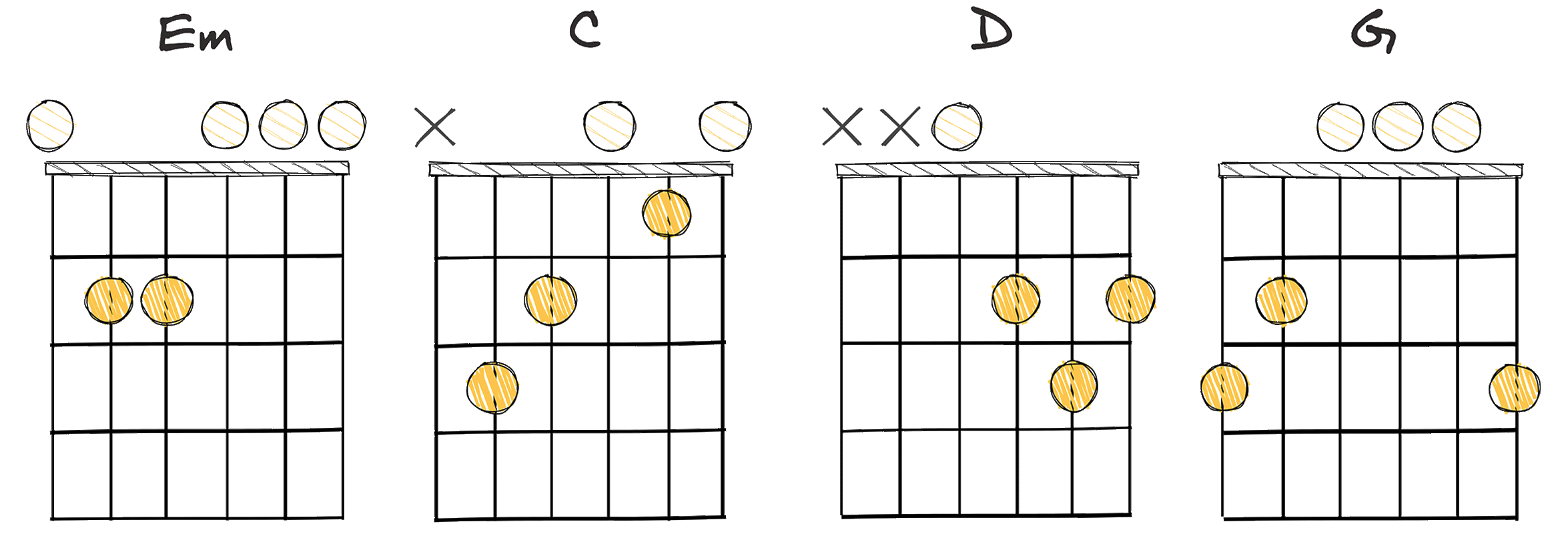
The vi-IV-V-I chord progression (6-4-5-1), follows a very popular pattern used in many hit songs across various genres and timespans.
Musical history reveals that these chord progressions have been the bedrock of many memorable tunes, weaving together harmonies that invoke feelings of happiness and contentment.
From upbeat pop tunes to soulful ballads, vi-IV-V-I facilitates a melodic framework that is simple, yet intricate in the emotions it conjures.
The most defining chord progression in popular music history, its relevance transcends the barriers of time and genre.
This chord progression particularly shines due to its flexibility and ease of play, making it a favourite among beginners and professional musicians alike.
No matter how new or experienced you are in your musical journey, the vi-IV-V-I chord progression presents an intuitive pattern that is easy to grasp and play.
Simple movements on the guitar fret or piano keys can lead to harmonic perfection encapsulated within this 6-4-5-1 progression.
Chord progressions like vi-IV-V-I offer a variety of options and allow musicians to create unique and emotionally captivating tunes.
From songwriters to instrumentalists, this progression is an ace up the sleeve when it comes to composing music that aims to uplift the listener’s spirit.
Whether it’s a soul-stirring anthem or a joyful jingle, vi-IV-V-I has, and will continue to be, a staple chord progression in a broad spectrum of music compositions.
Learning to master this progression can certainly open up a wealth of options, providing the right harmonic backdrop to express a range of emotions through music.
I-iii-vi-IV (1-3-6-4)
A joyful journey through uplifting optimism in a musical universe.
The I-iii-vi-IV progression is a joyful sequence commonly used in a variety of music genres for its uplifting effect. Rooted in the major key, its transition from the tonic to the mediant and subsequently to the submediant and subdominant, creates a harmonious sound that invigorates and enlivens the listener’s mood.
- Difficulty: Easy
- Example: G – Bm – Em – C (Key of G Major)
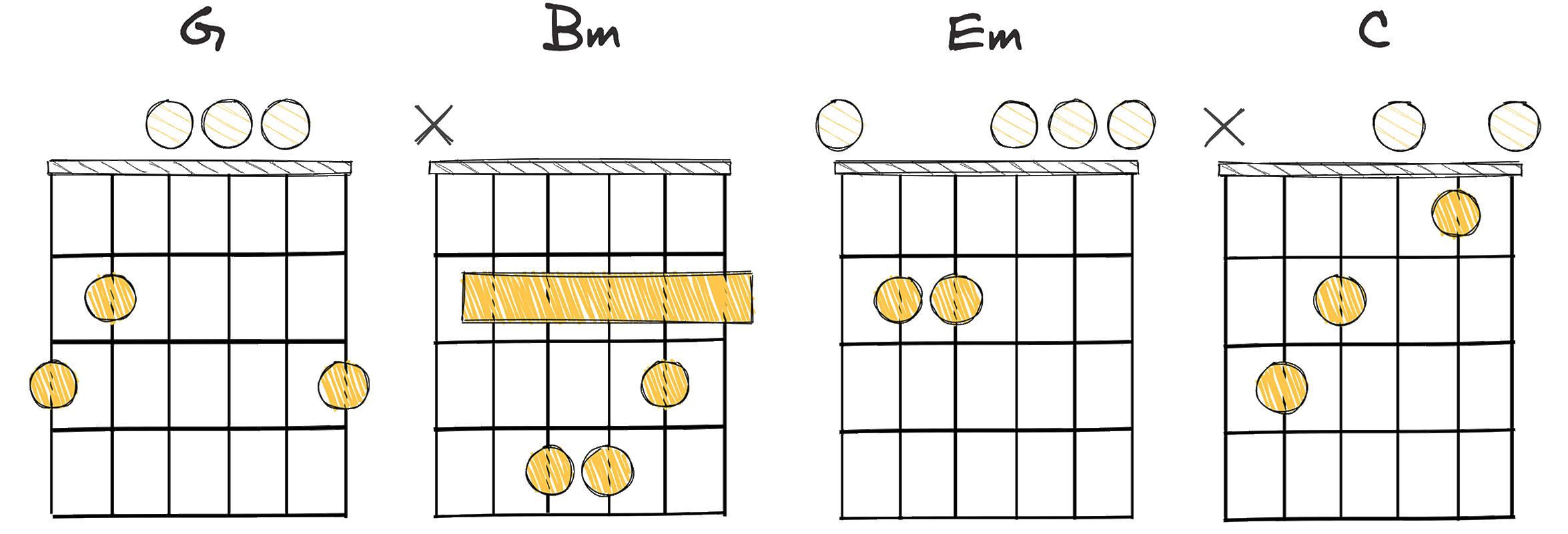
The I-iii-vi-IV chord progression is a common sequence of chords in various genres of music.
Its universal appeal stems from its ability to convey an uplifting and joyful mood when used in a song.
This chord progression is often associated with a sense of progress or resolution, which adds to its appeal.
As such, it can be a powerful tool when used correctly in songwriting.
The unique arrangement of the chords inherently provides a sense of harmony and completeness.
The I-iii-vi-IV chord progression creates a circular feeling, as the last chord (IV) naturally leads back to the first (I).
This gives the progression a cyclical quality, which can be very appealing to the listener.
It often leaves them wanting more, drawing them into the song more deeply.
The formation of this progression, in the Key of G Major, presents as G – Bm – Em – C.
These chords are easy to play, and the progression is not complex to understand, making it ideal for beginner guitarists and songwriters.
Due to its simplicity and the harmonious relations between the chords, the I-iii-vi-IV progression is often used in pop music, but can be found in any genre.
The joy and serenity it brings to a musical piece truly have the ability to uplift one’s spirit.
Easy to understand, easy to play, and universally appealing – This is the essence of the I-iii-vi-IV chord progression.
I-IV-V-vi (1-4-5-6)
A vibrant progression radiating joyous energy and elevating melodic spirit.
The IV-I-V-vi chord progression embodies the quintessential upbeat sound, popular in many uplifting and happy songs. Its smooth transition from the IV to I echoes a satisfying resolution, while the shift to V and VI chords introduces an engaging variation.
- Difficulty: Easy
- Example: A – D – E – F#m (Key of A major)
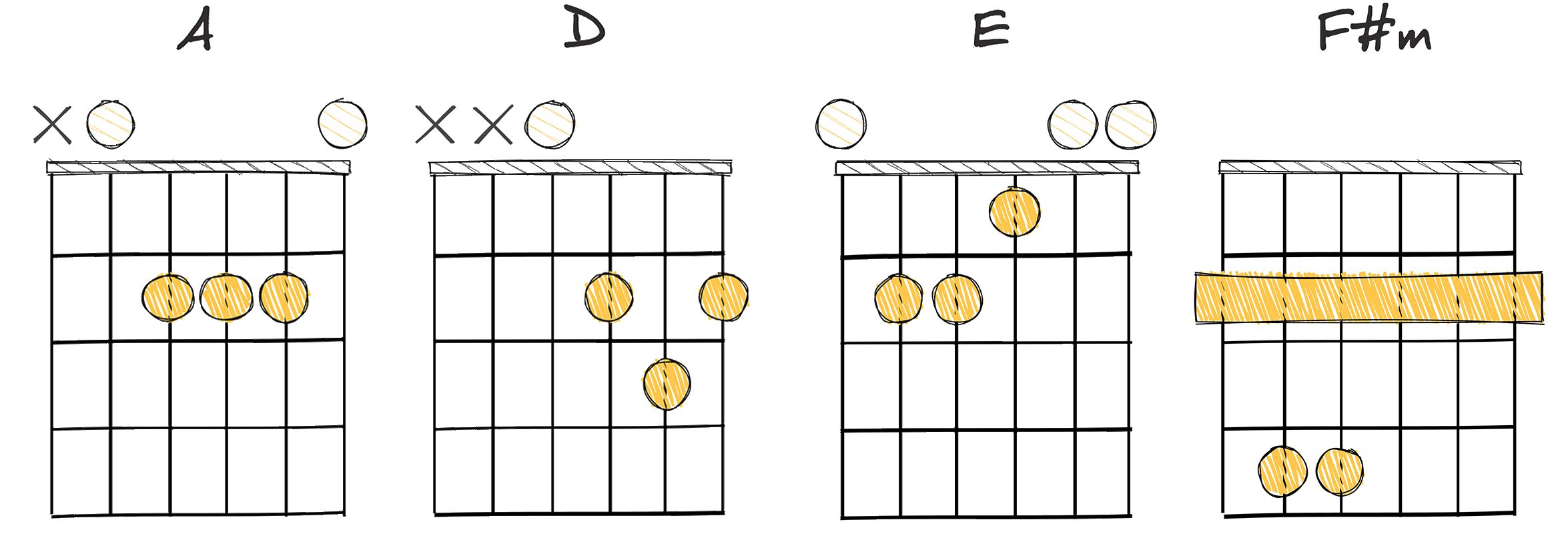
This particular chord progression is truly enchanting and often utilized in popular songs due to its simplicity and ability to invoke feelings of happiness and positivity.
Highly regarded for its cheerful elements, stroke of creativity and ease of play, the chord progression I-IV-V-vi is essentially a recipe for creating uplifting music.
This chord progression is remarkable in its ability to uplift spirits, hence why it is often used in songs with a happy theme.
The progression sequence starts with the IV chord, provides a sense of movement, then resolves beautifully back to the home chord, the I chord, thereby contributing to the joyous feel.
In essence, this chord progression is elegantly simple, but produces a sound that is delightfully complex and pleasing to the listener’s ear.
The chord progression, I-IV-V-vi (1-4-5-6), has a rich history in the realm of music.
Throughout the decades, countless musicians spanning various genres have incorporated this progression into their works.
Specifically, on a guitar, it requires basic open chords, except for the F#m chord, which is really not that hard to play either.
This ease of play enhances the accessibility of this chord progression to musicians at different skill levels, increasing its usage and popularity.
Ultimately, the I-IV-V-vi progression in the key of A major showcases its appeal across artists and genres, spreading its uplifting vibes to all music lovers.
V-iii-IV-I (5-3-4-1)
A bright, uplifting progression, grounding energy with resolved tension.
The V-iii-IV-I progression is a cheerful sequence often used to evoke a sense of uplifting joy and positive energy in music. Starting from the dominant chord and transitioning through the mediant and subdominant, before resolving back to the tonic, it provides a satisfying, happy ending that pleases the ear.
- Difficulty: Intermediate
- Example: A – F#m – G – D (Key of D major)
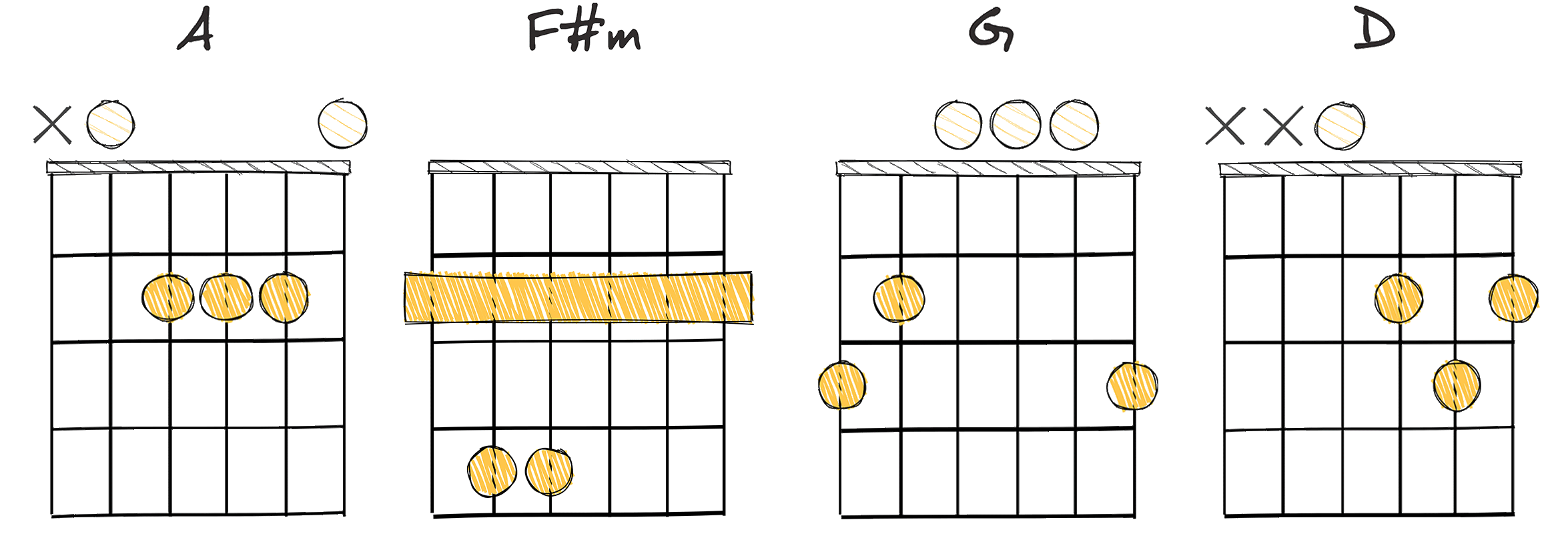
The chord progression V-iii-IV-I (5-3-4-1) is classified as an intermediate level progression, requiring a certain level of comfortability with strumming patterns, chord changes, and transitions.
However, it’s one that is certainly worth mastering given its rich musical flavor it provides to a song.
Speaking historically, musicians have always used this chord progression to inject an uplifting spirit into their compositions.
The exact origins of this chord progression are hard to pinpoint but it has been a staple in music across genres and eras.
There’s a universal appeal to the V-iii-IV-I progression.
It’s a happy-sounding progression, evoking emotions that resonate across cultural boundaries.
As the quote suggests, these four chords work together to create a refreshing and positive feeling, making songs that use this progression instantly appealing and emotionally uplifting.
When played in sequence, the transition from V to III to IV to I triggers a sense of resolution and harmony, putting listeners in a positive, upbeat mood.
Each chord in the progression – A – F#m – G – D (in the key of D major) carries its own energy and combines to produce an invigorating and pleasant melody that sparks joy and positivity.
Looking at this progression within the broader scope of music theory, V-iii-IV-I progression is interesting because it incorporates both a major chord and a minor chord.
This creates an intriguing contrasts of emotions and tones within the same piece of music.
The flexibility of this progression is also worth noting.
Taking the progression’s flexible nature into consideration, it becomes apparent why it’s such a popular choice among musicians.
Not only does it cater to a happy and uplifting sound, but it can be tailored to fit a wide range of musical styles, from pop to rock to country and beyond.
The mastering of this chord progression opens up possibilities for varied songwriting and composition, enabling you to infuse your music with a powerful sense of positivity and brightness.
Playing the V-iii-IV-I progression doesn’t just benefit the listener, it also provides satisfaction and accomplishment for the musician.
Ultimately, embracing and incorporating this progression into your repertoire is a rewarding endeavor, providing the opportunity to further expand your musical understanding, versatility, and capacity for creating resonant, uplifting music.
I-vii°-vi-IV (1-7-6-4)
A harmonious mix delivering a unique burst of musical joy.
The I-vii°-vi-IV chord progression is a delightfully captivating sequence that is often used in a variety of music genres due to its uplifting and positive feel. This progression starts from the root, descends a whole step, and then descends a half-step before leaping down to the fourth, producing a mood of happiness and optimism.
- Difficulty: Easy
- Example: G – F#dim – Em – C (Key of G major)
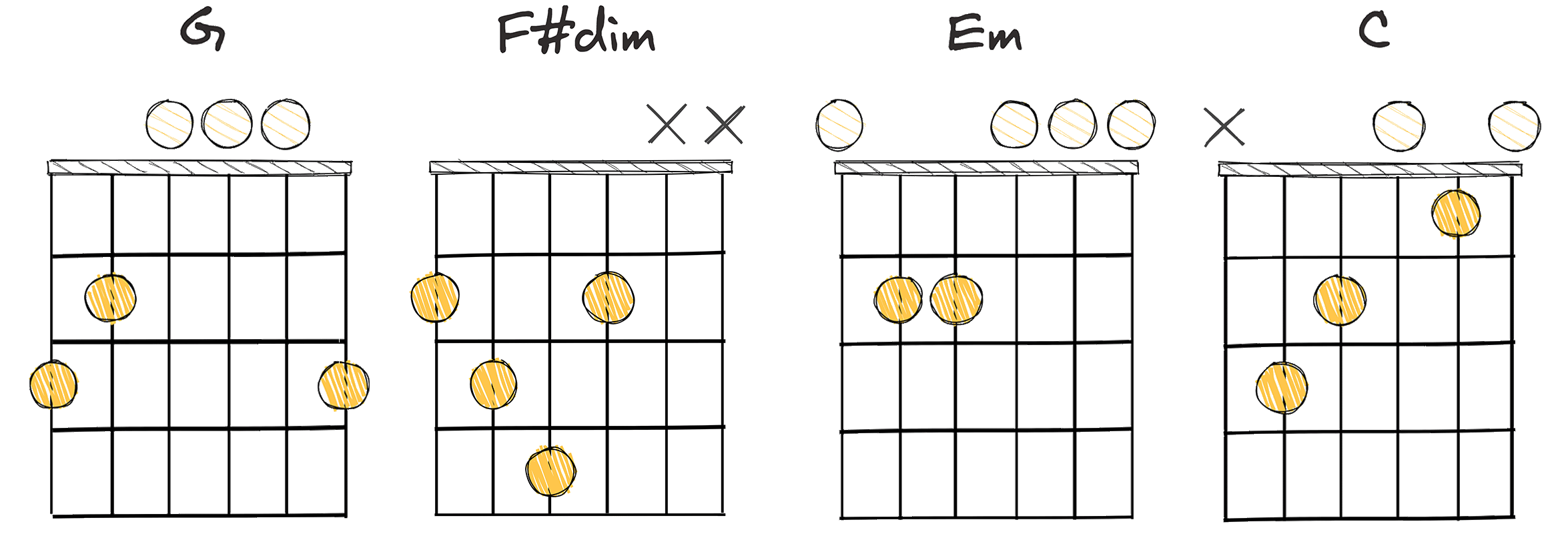
In the realm of uplifting and cheerful tunes, the I-vii°-vi-IV or the 1-7-6-4 chord progression unequivocally holds a notable place.
This progression, rooted in the key of G major, has long been a staple in creating tunes that evoke a mood of joy and positivity.
The 1-7-6-4 chord progression, when translated to the key of G major, represents the chords of G-F#dim-Em-C.
Even in the absence of lyrical content, the chord progression itself subtly sets the overall mood and message of the song.
When analyzing the progression history, the I-vii°-vi-IV progression appears relatively simple to implement and play.
Yet, its simplicity does not compromise its capacity to generate a significant emotional response from the listener.
Its usage spans various genres, from pop classics to rock anthems, highlighting its versatility and universal appeal.
Being easy to play, this progression can be a great starting point for budding musicians to enhance their understanding of harmonics and melody creation.
This approachability promotes musical experimentation, empowering artists to materialize their own unique interpretations of joy and cheerfulness in musical form.
Remember, despite the simplicity of these chord sequences, elusive component is the creativity and genuine emotion of the artist behind the composition.
Truly, music is a conduit of emotions, and such chord progressions act as essential tools facilitating that transfer.
As we continue exploring the multifaceted world of chord progressions, let’s keep discovering how distinctive arrangements of chords translate into the narratives of songs that eventually connect with our souls.
To revere music is to revere the magical potential within its harmonies, progressions, and ultimately, its capacity to reflect and amplify human emotions.
IV-iii-ii-I (4-3-2-1)
A joyful descent to resolution, perfect for a uplifting finale.
The IV-iii-ii-I chord progression, also known as the 4-3-2-1 progression, is a series of four chords that decrease sequentially. This progression is widely recognized for its upbeat and uplifting qualities, making it a popular choice for musicians seeking to create a happy, positive mood in their compositions.
- Difficulty: Intermediate
- Example: G – F#m – Em – D (Key of D Major)
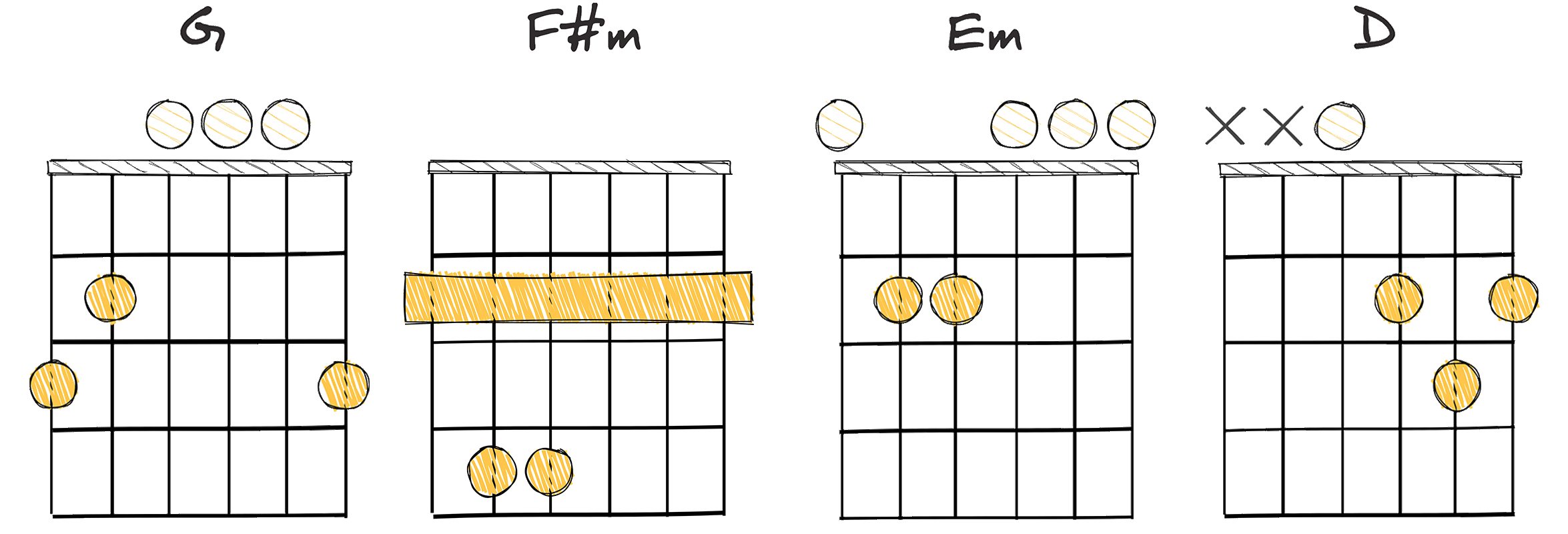
The chord progression IV-iii-ii-I (4-3-2-1) boasts a rich tapestry of history.
Hailing from the intermediate stage of musical progression, it requires a slightly more seasoned hand to execute flawlessly.
The implementation of this chord progression can bring a unique sense of satisfaction, making it a favorite among many musicians.
This progression is renowned for evoking a sense of finality or winding down, giving it an uplifting, positive tone.
As it moves from the fourth to the first chord, we experience a pleasing resolution that provides a sense of coming home.
It’s important to understand that utilizing this progression requires a strong grasp of music theory and an ability to weave intricate melodies around harmonious chords.
Shifting your focus to an equally iconic example provides more context – the chord progression D – G – Bm – F#m (Key of D Major).
It is noteworthy that the use of minor chords in the second half of this progression introduces an interesting detour into a more contemplative mood before returning to the major chord, adding depth and dynamism to the music.
As a consequence, this makes for an inspiring arrangement and can be found in numerous hits across various genres.
A keen understanding of this progression allows songwriters to imbue their music with a sense of tranquility, resolution, and harmonic closure.
Popular among both artists and listeners alike, the chord progression IV-iii-ii-I (4-3-2-1) carries with it a unique musical charm.
It is, arguably, one of the most delightful ways to uplift your musical spirit.
V-I-IV-vi (5-1-4-6)
A refreshing progression, carrying hopeful undertones, for a buoyant musical mood.
The V-I-IV-vi progression provides a bright, cheerful mood due to the resolution from the 5th to the 1st and then increasing the tension with the 4th and 6th chords. This progression is commonly used in pop and rock songs, offering a uplifting feel and causing a listener’s musical spirit to soar.
- Difficulty: Easy
- Example: D – G – C – Em (Key of G major)
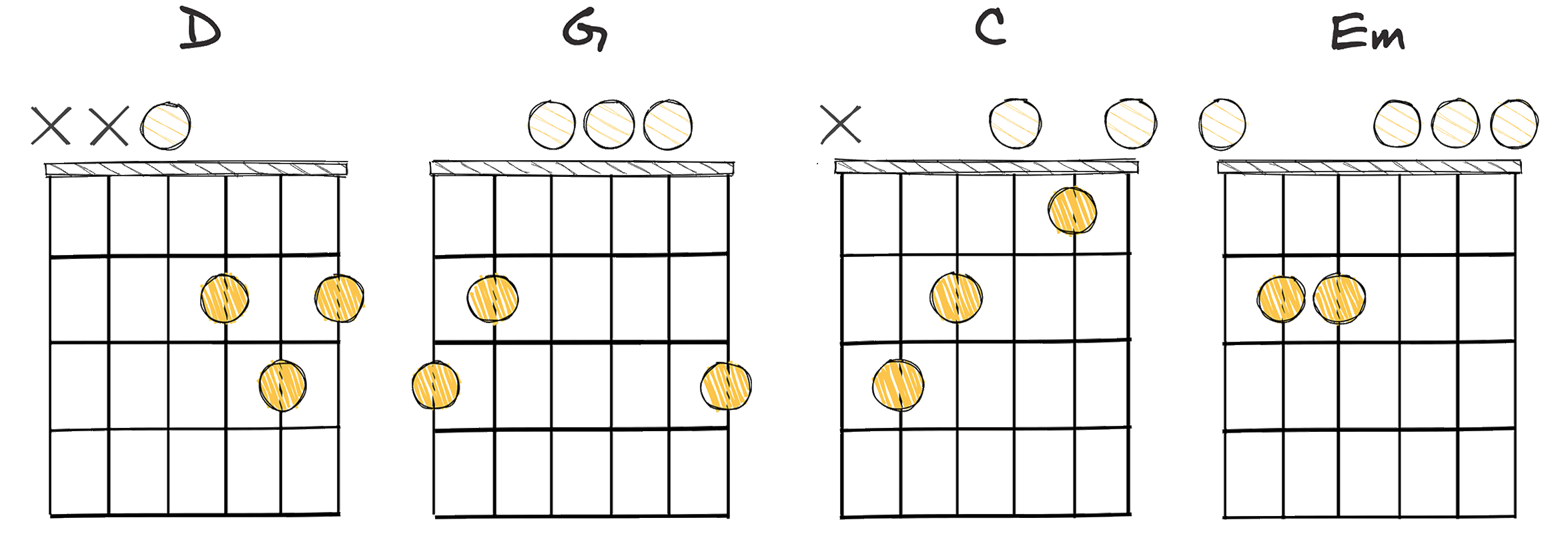
The V-I-IV-vi chord progression is one of the well-loved chord progressions in the world of music.
This progression has a rich history woven into numerous classical and modern music compositions.
It is renowned for its unique tonal quality that evokes a mix of emotions, often associated with a positive and uplifting spirit.
Frequently used in pop and rock genres, this chord progression has played a significant role in shaping the soundtrack of our lives.
It is easy to play, which allows both seasoned musicians and novice players the ability to bring out the emotional strength of this progression.
This ease of play makes it suitable for band jam sessions and solo performances alike.
The progression’s popularity extends beyond its simplicity – it’s the captivating power it holds that leaves the audience and performers alike in a state of musical bliss.
The Bottom Line
Ultimately, the chord progressions listed above represent the most common sequences utilized in a wide range of music genres.
Understanding these progressions is essential for any songwriter or composer, as they provide the foundation for building a pleasing harmonic structure.
Mastery of these sequences can enhance the ability to create music that resonates with audiences, due to the familiar and comfortable sound they produce.
Additionally, introducing variations to these standard progressions can add a unique twist to any composition, promoting creativity and artistic individuality.
Therefore, a solid understanding of these chord progressions can lead to a wider range of musical creativity and expression.
In love with guitars, and gear; expert in all things music! Been writing about guitars for about 5 years and counting. Born in the ’90s. Alma Mater: University of Havana. Always curious, trying to understand the world. #TeamFender




